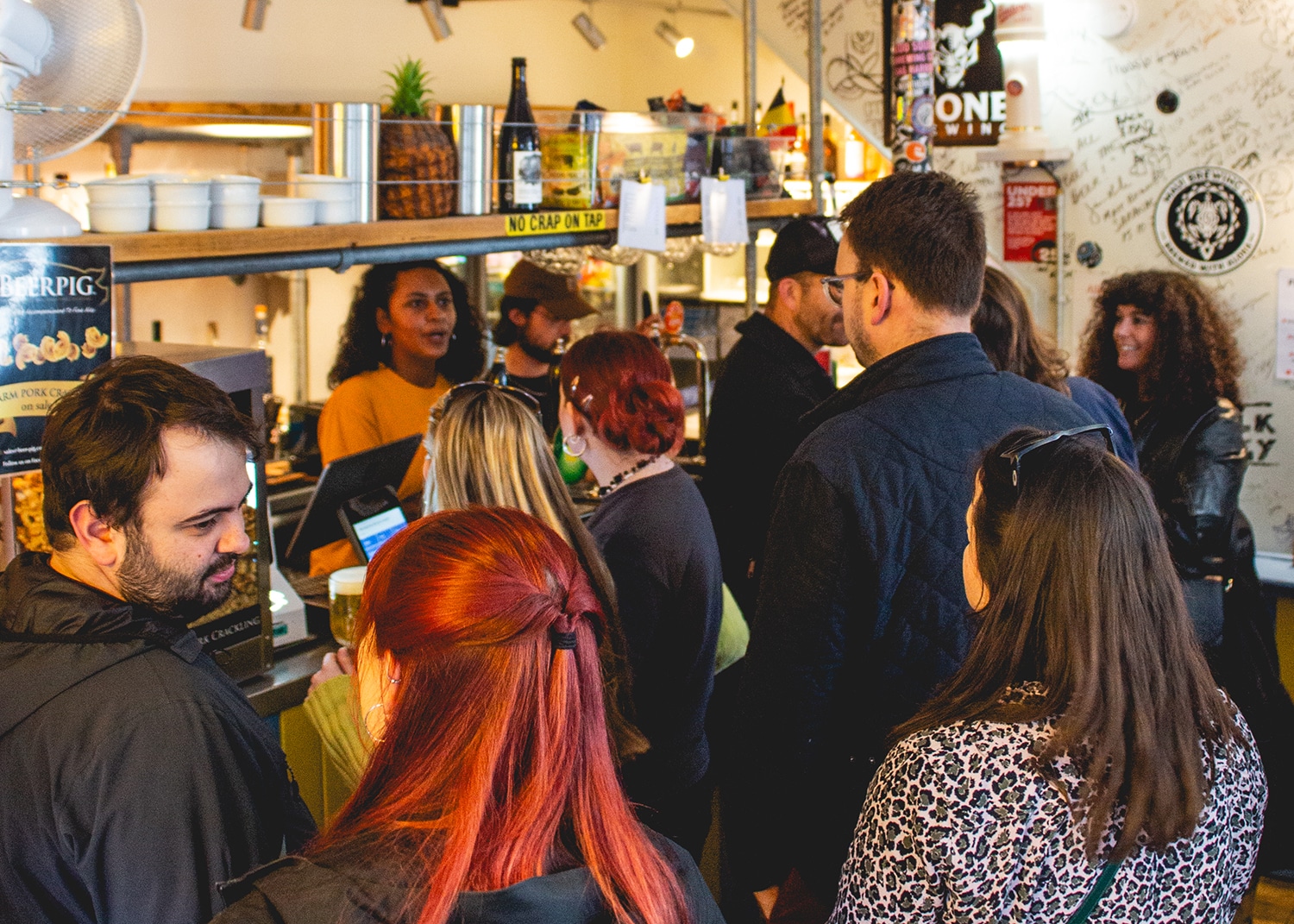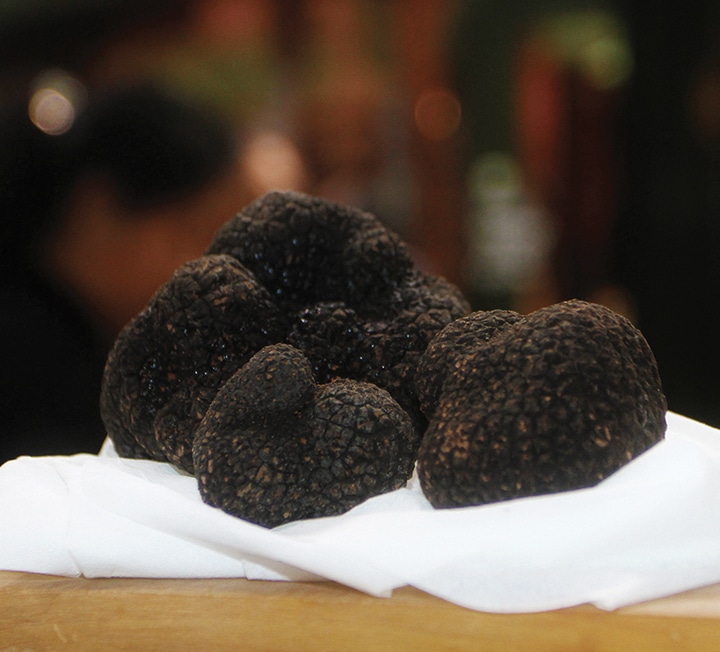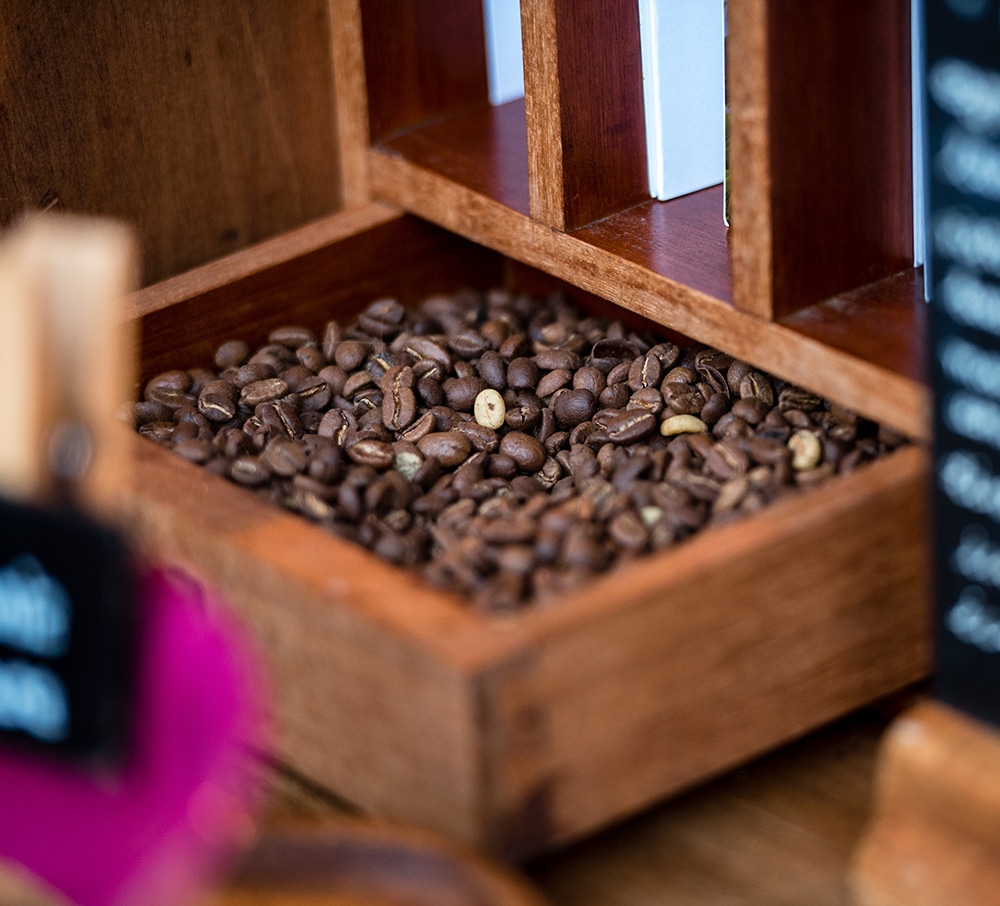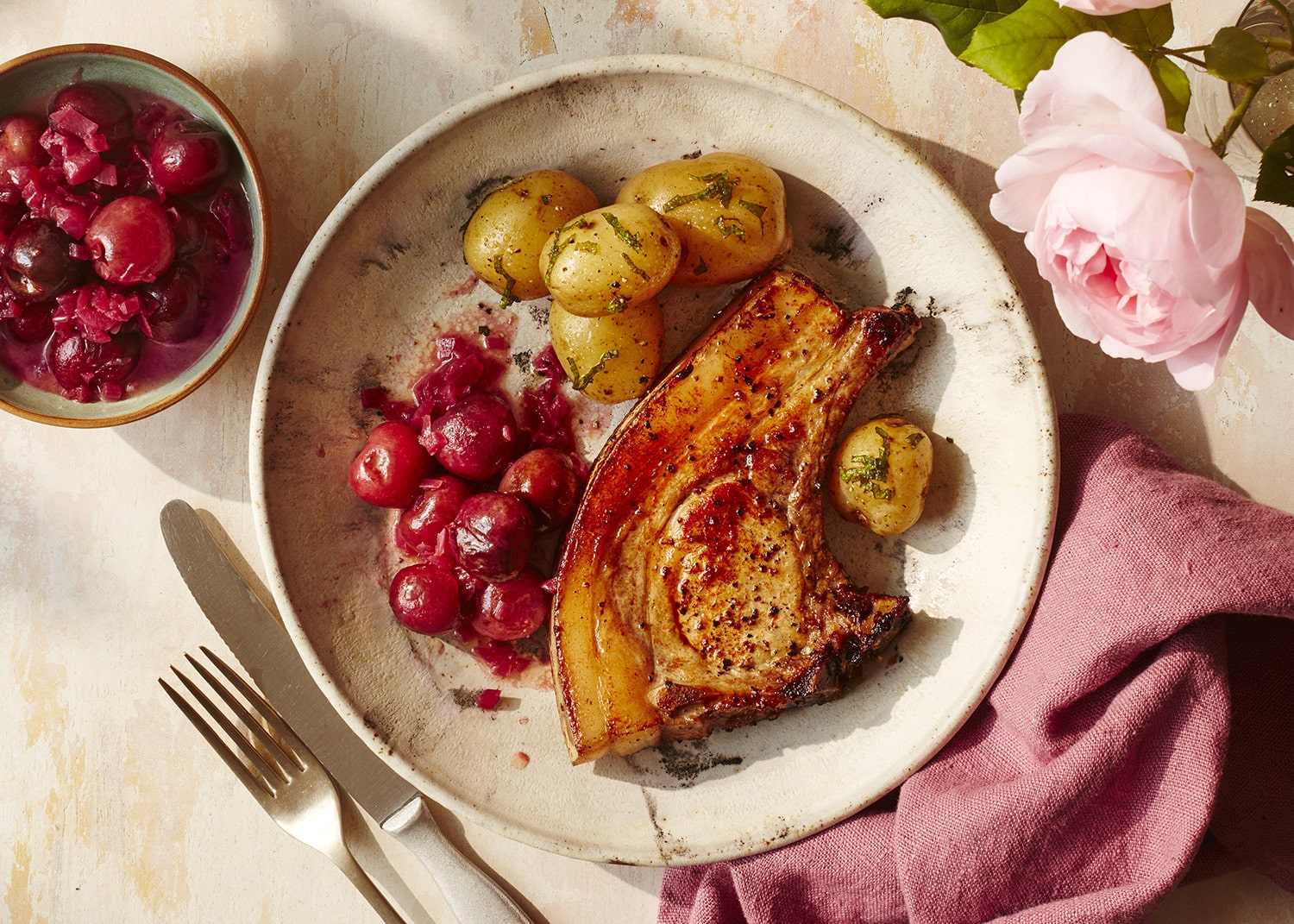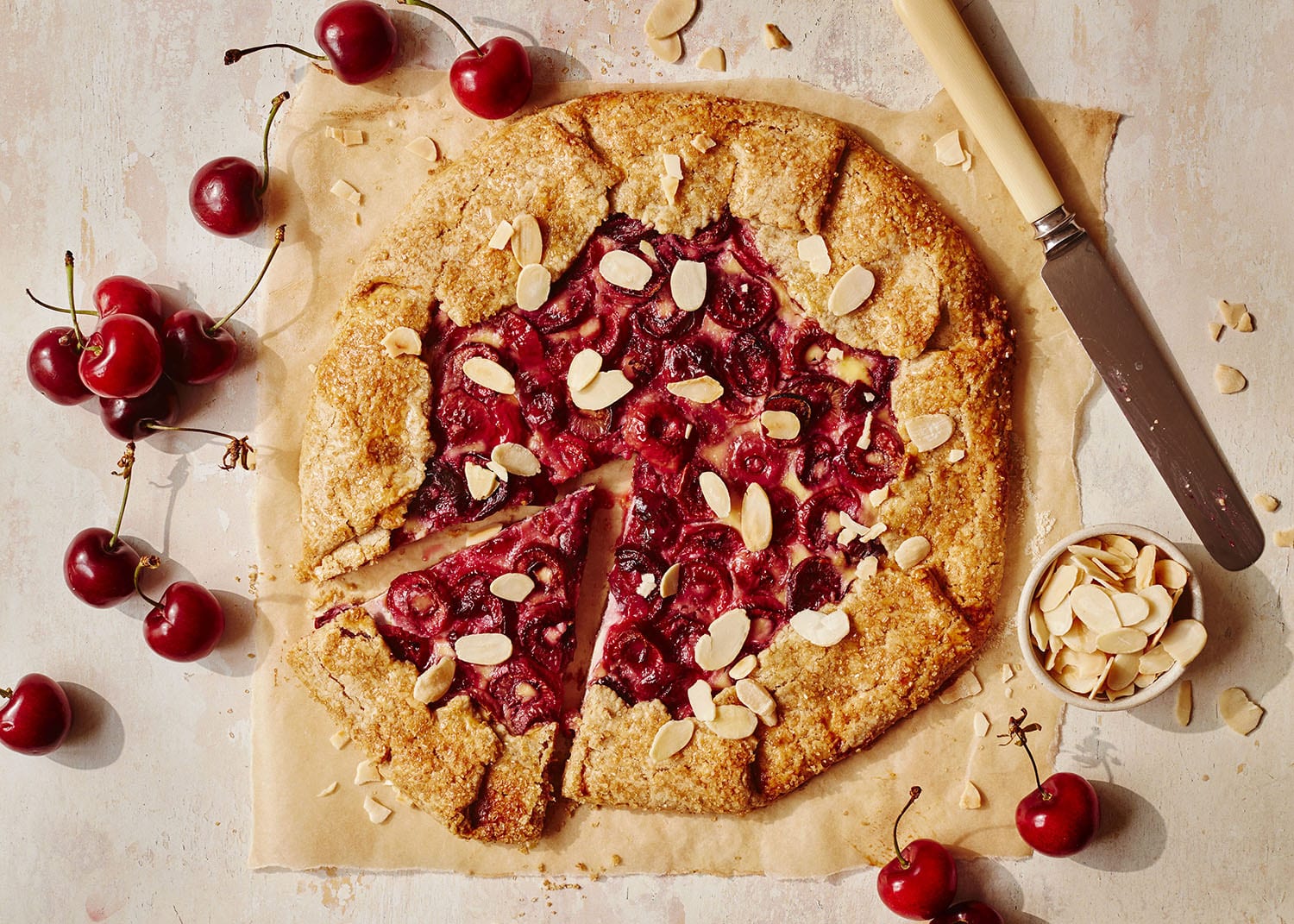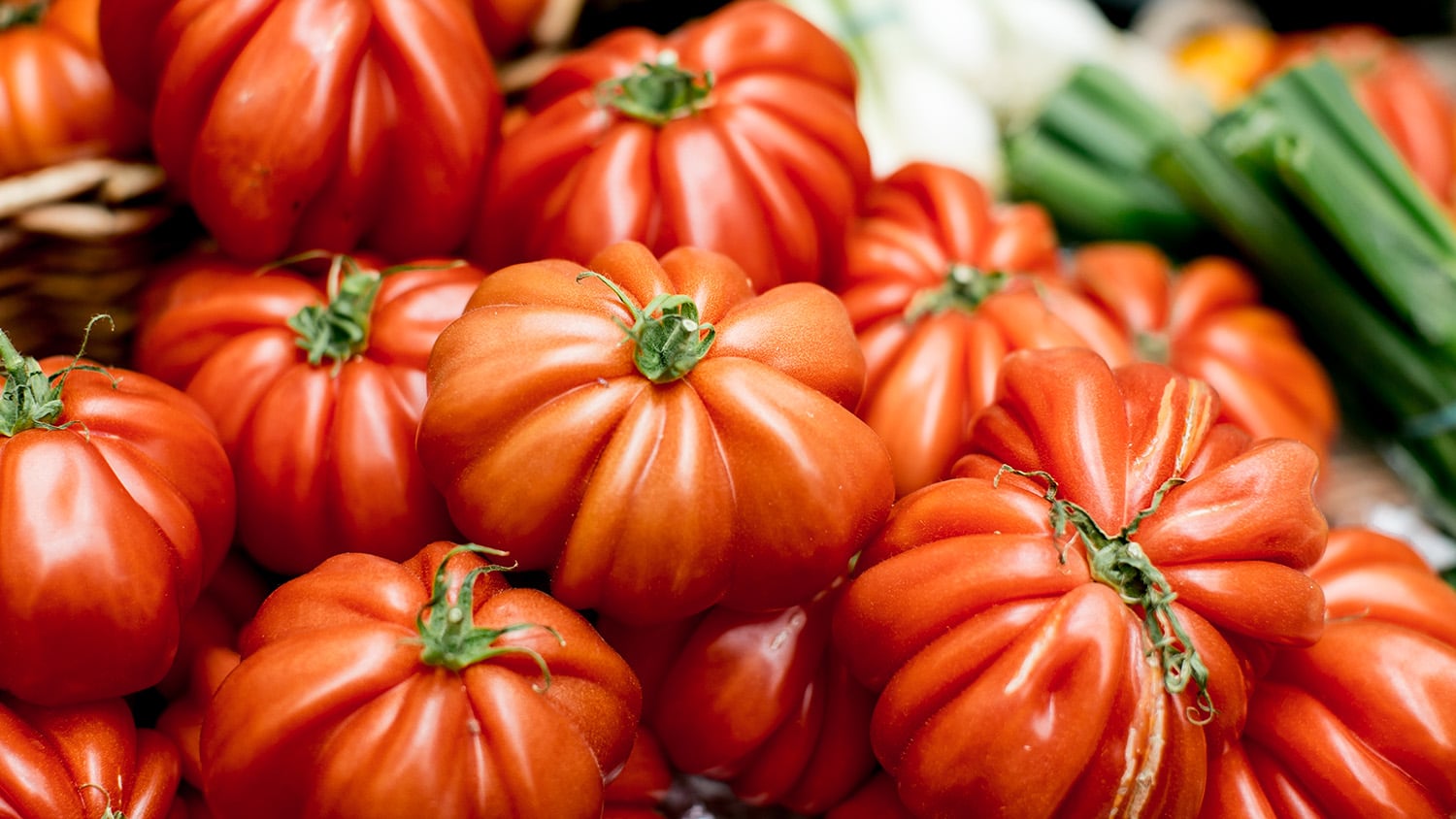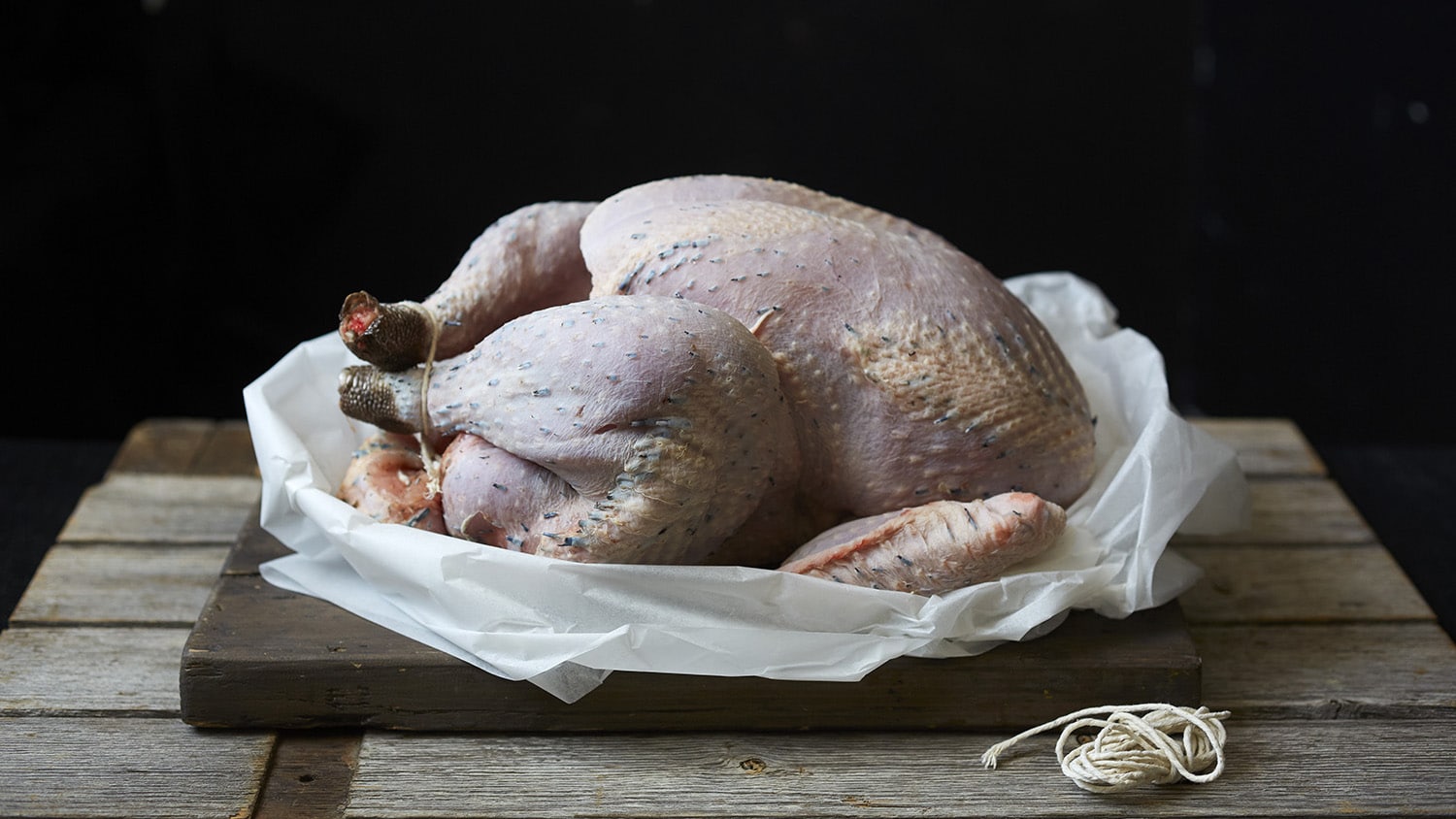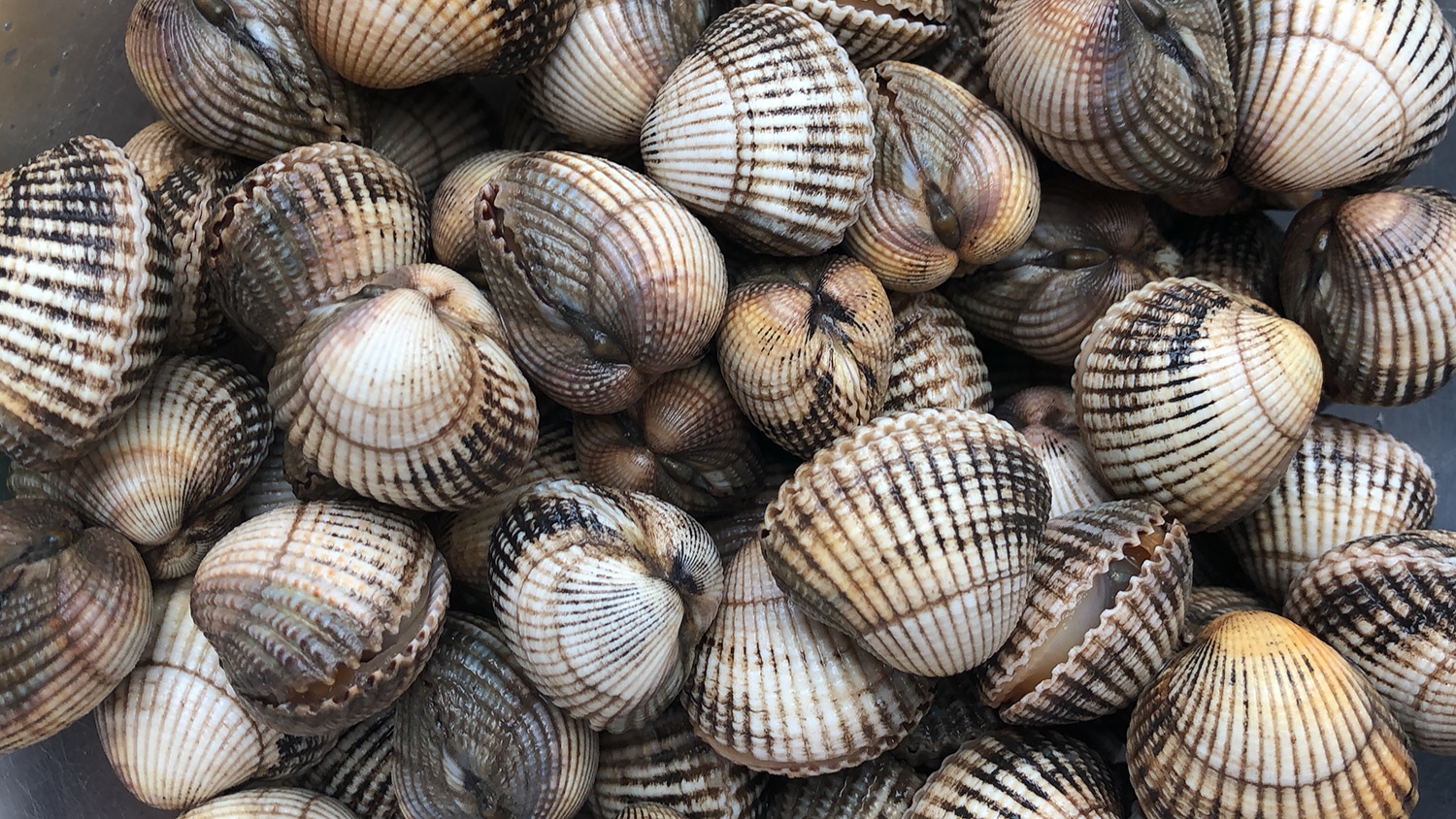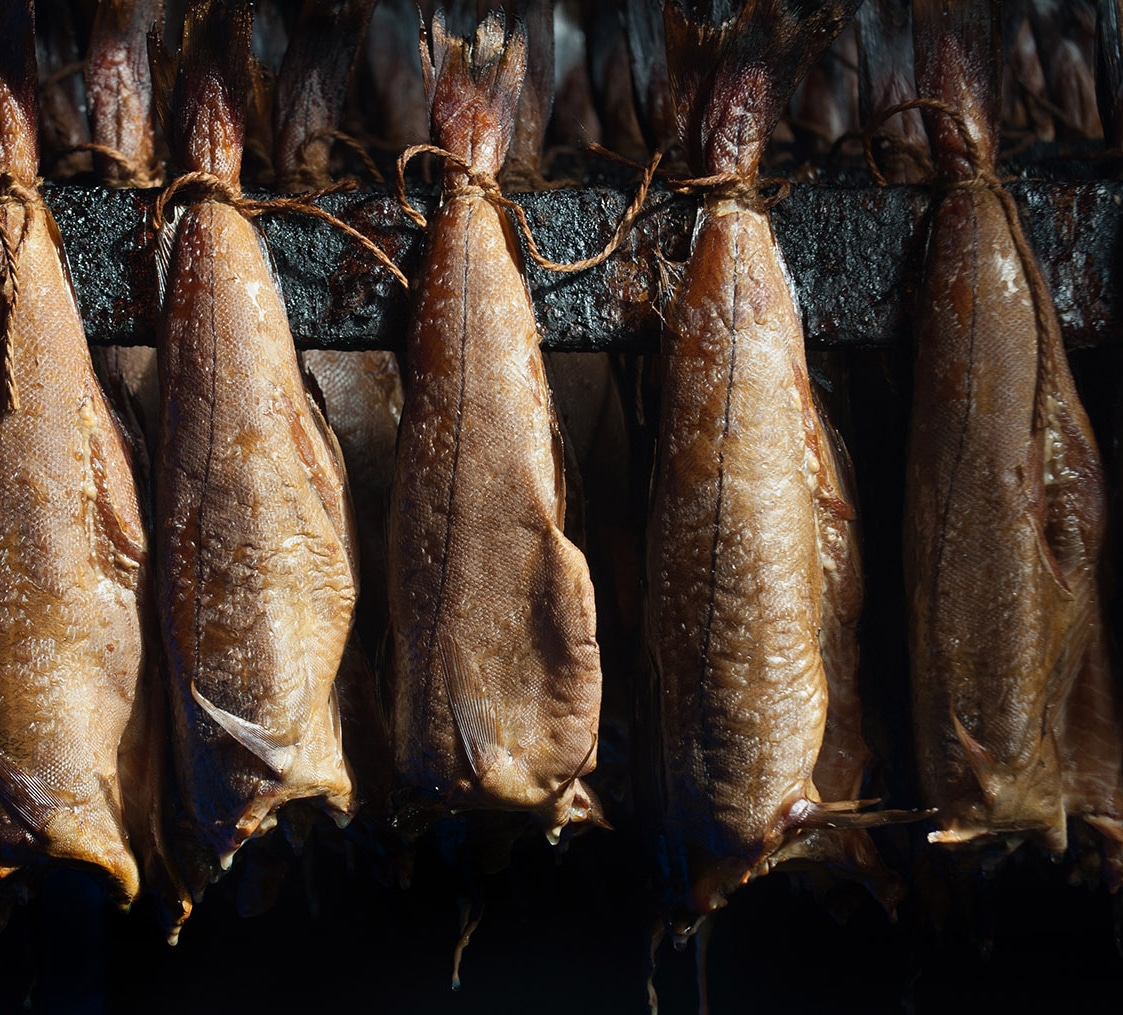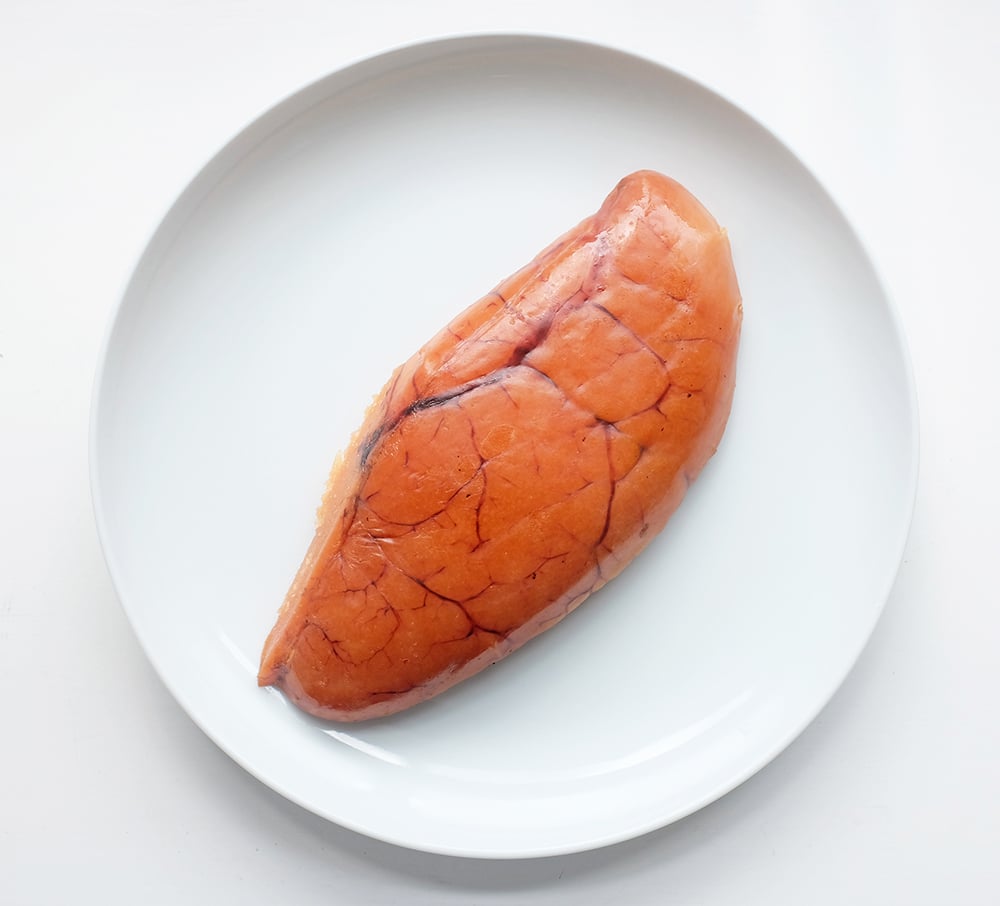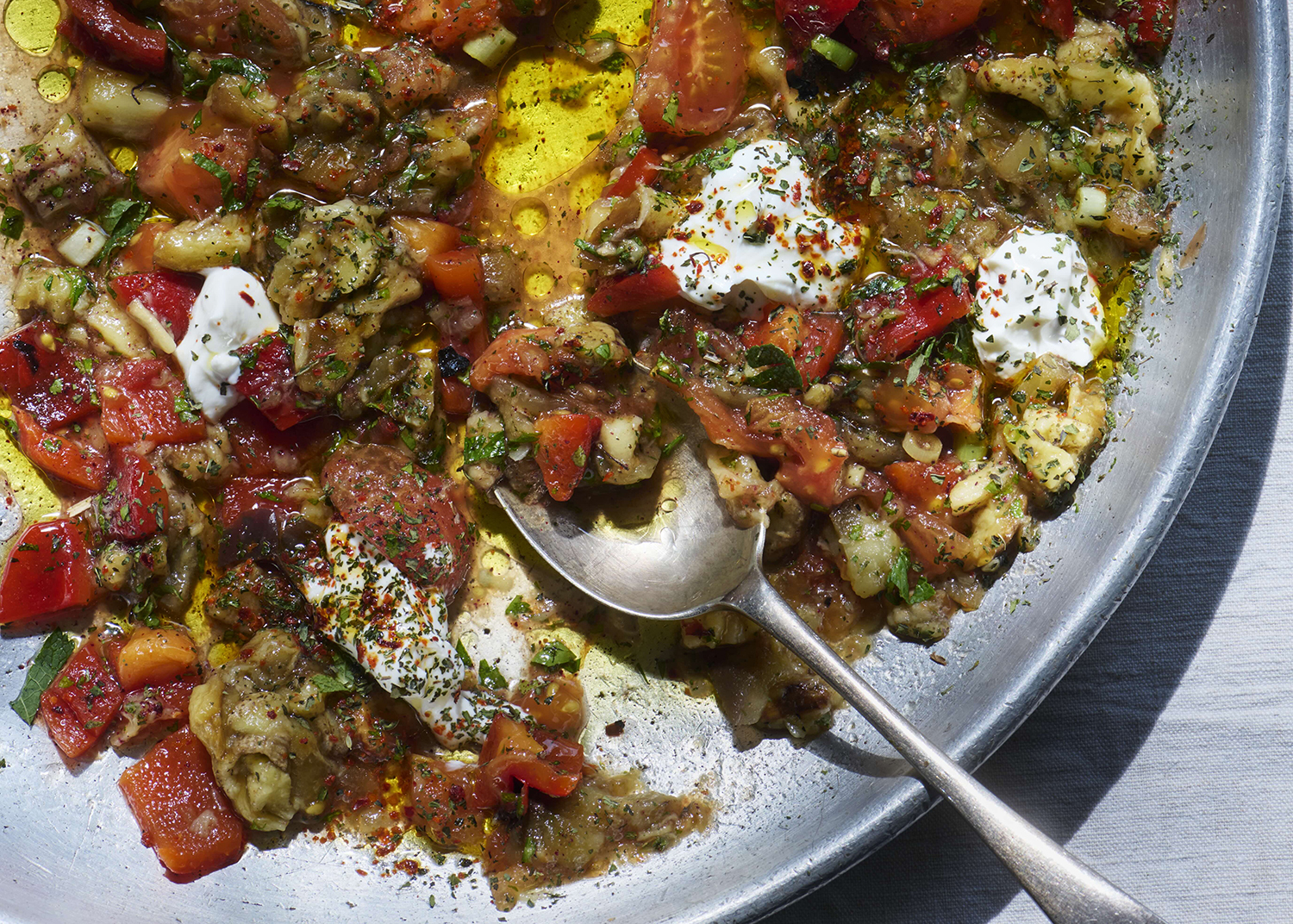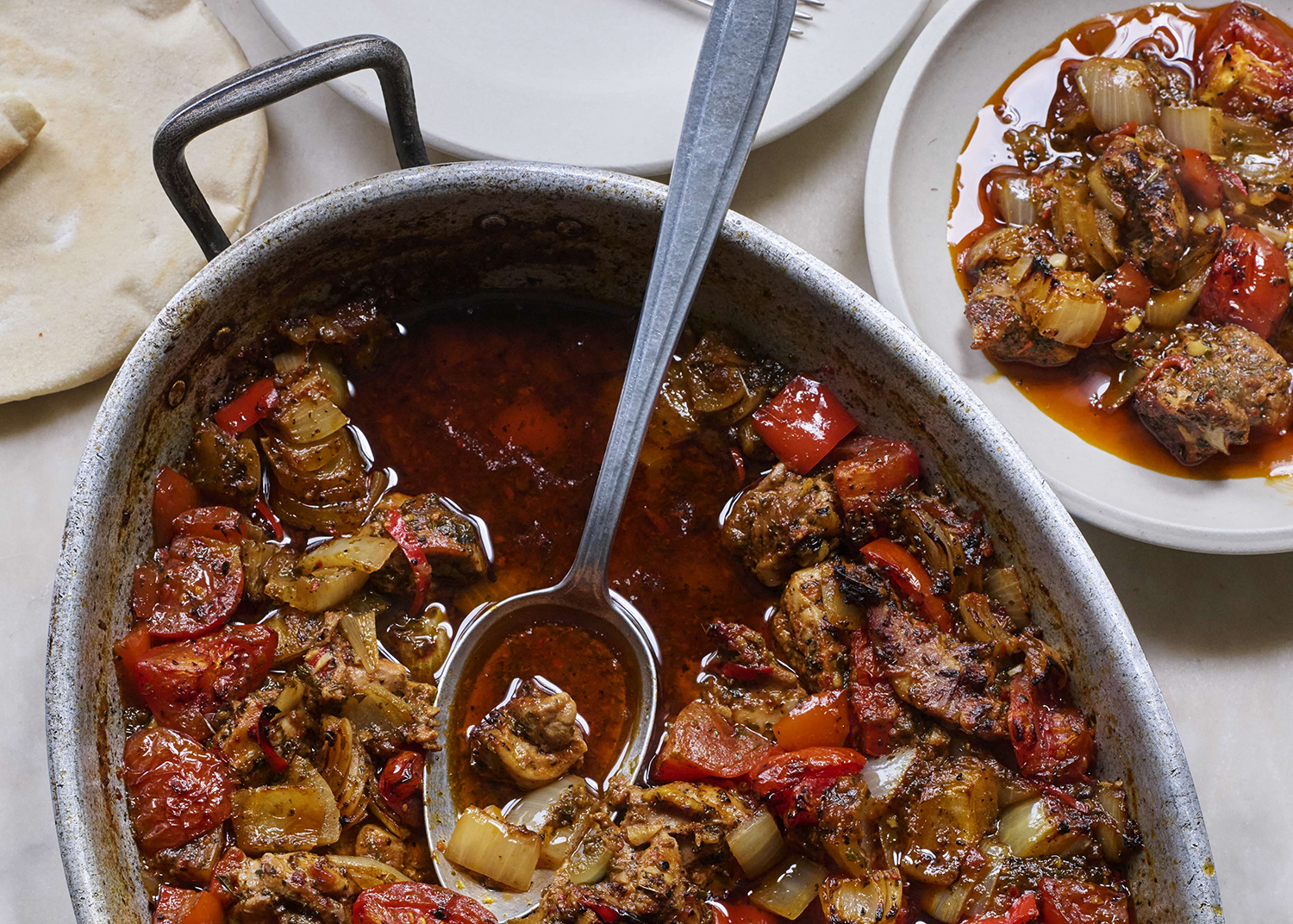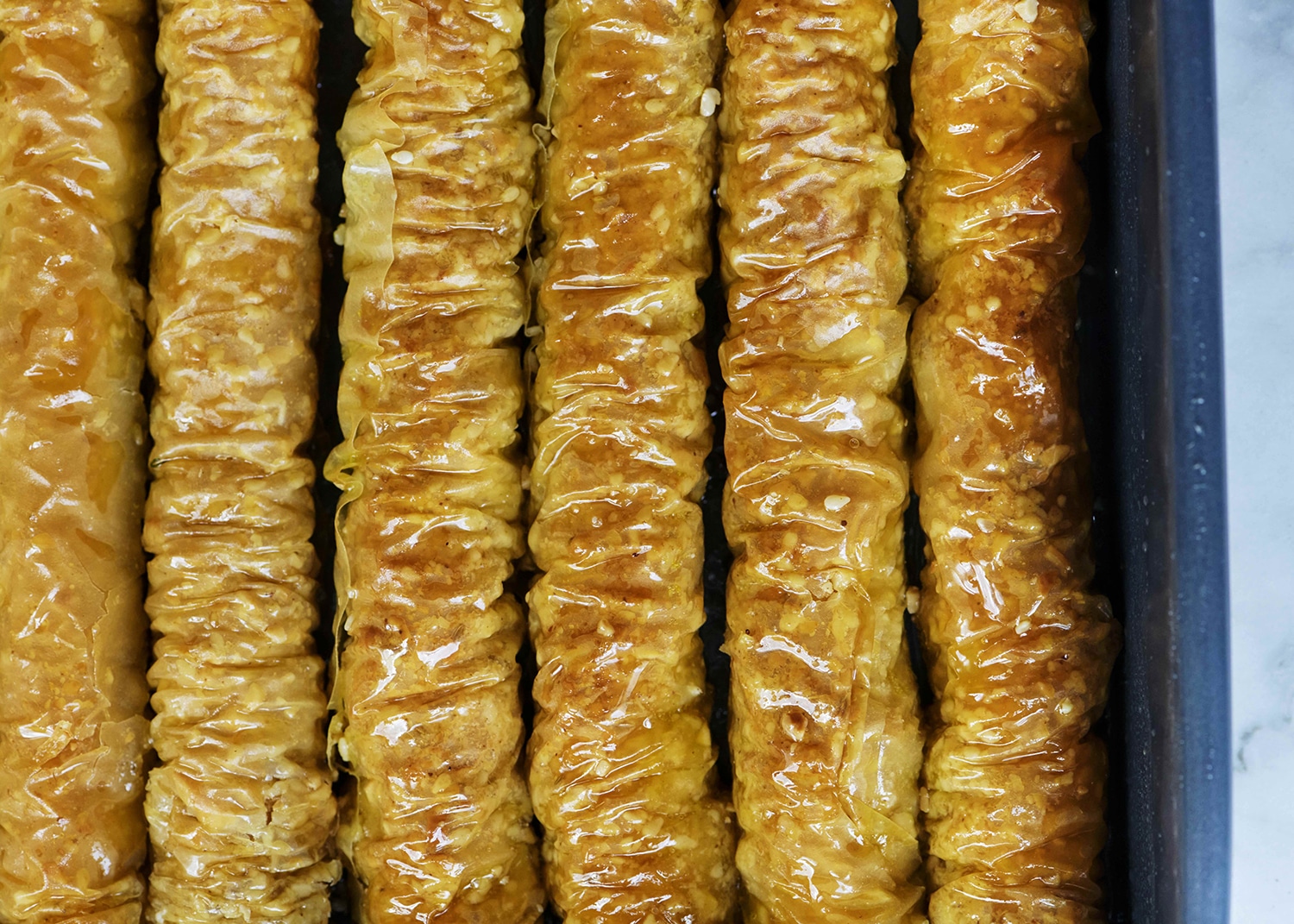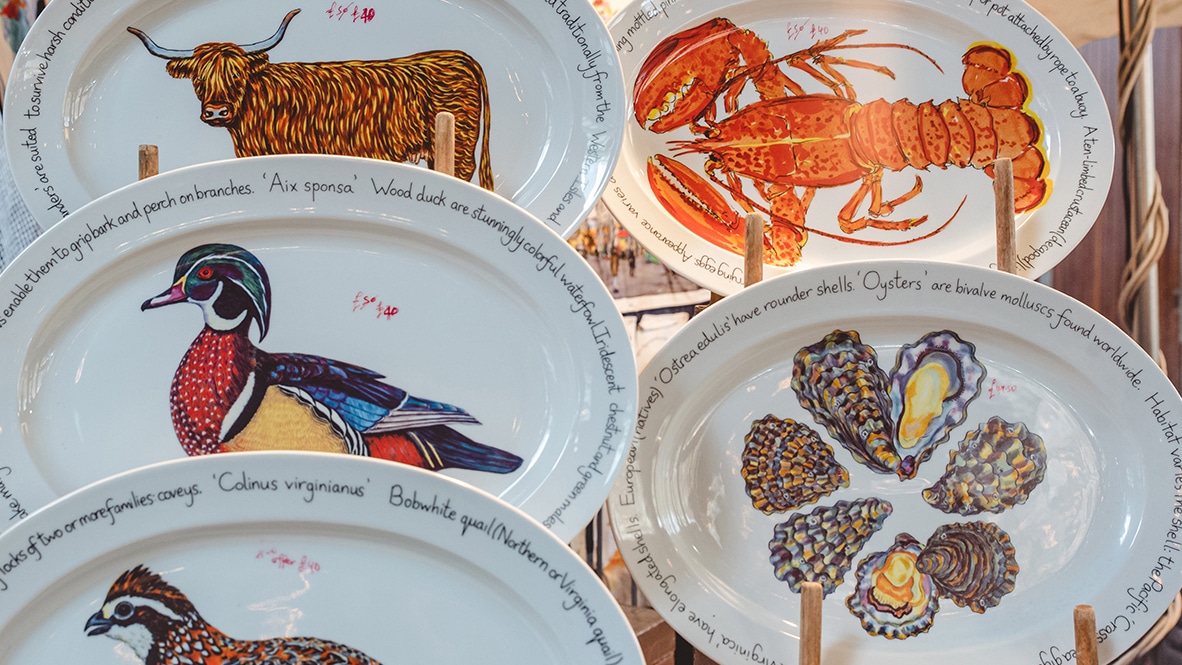Jimi’s journey
Writer and broadcaster Jimi Famurewa on how, after a very rocky start, he grew to love food markets – and how some of Borough’s traders did the same


“AS A CHILD, MARKETS MEANT SQUISHED TOMATOES ON THE PAVEMENT, RANK SMELLS AND STULTIFYING BOREDOM”
Words: Jimi Famurewa / Images: Tom Miles, Orlando Gili
As a restaurant critic and inveterate food obsessive, there are few places I love more than a produce market. The vibrant, heaped displays of vegetables, fruit and glinting fresh seafood; the constant thrum of bodies and laden, twist-tied paper bags being passed from one hand to another. The lively traders calling out through the commingled waft of fresh herbs, ripe cheeses, and fried onions drifting from a street food stall. These days, whether it’s the bountiful, organic sprawl of Borough Market or a local gathering of a few fruit and veg carts, a market will always make me smile.
But when I was growing up, things couldn’t have been more different. Market day meant my mum hauling me to Woolwich or Deptford on a Saturday – an interminable fetch-quest of grocers, butchers and bakers, when all I wanted was to be planted on the sofa watching cartoons. The market to me was squished, overripe tomatoes on the pavement, unfamiliar, rank smells and stultifying boredom as adults haggled and nattered for what felt like an eternity. None of this was especially out of character for me. As I have detailed in my new book, Picky – a memoir about eating, identity and how I went from fussy, junk-addled kid to adventurous, professional gourmand – my childhood was one where the messy realities of fresh food tended to inspire fearful squeamishness rather than excited curiosity.
My allergy to open-air costermongers was very much par for the course, then. But you would expect someone who earns their living as a food producer and market trader to have experienced a markedly different trajectory. So it’s a surprise, to say the least, for me to learn that even some of Borough Market’s most respected traders once regarded markets with a similar youthful trepidation. “I grew up in Kingston, Jamaica and early on Saturday morning my grandmother would take me to a place called Coronation market,” says Dawn Smith, founder of Pimento Hill, a beloved purveyor of vibrant Caribbean sauces, seasonings and preserves at Borough since 2010. “It was fresh food and fresh gossip, and I hated everything about it. The handcarts, the people shouting, the smells and the noise.”

Though Coronation’s grisly assault on the senses was especially challenging for Dawn (“When they’d bring that bit of meat for my grandmother and just wrap it in paper, I’d say to myself: ‘I am so not eating that’”), it was also the social exchange and whisper network of the adult world that she struggled with. “My grandma would be catching up with gossip and, as a child, I just had to stand there and keep my mouth shut,” she says. “I couldn’t even pretend to be interested in the conversation, because I’d be told: ‘Why are you listening? Nobody’s speaking to you.’”
This bewilderment at the grown-up interplay of markets was also felt by Stephen Hook – Sussex-raised farmer and owner of trailblazing unpasteurised dairy business Hook & Son – when he first experienced markets with his father. “These were livestock markets and so I’d be seeing all these characters,” he says. “They’d be bidding in their own particular ways, with a wink, or a tap of the nose or whatever.” By the time Stephen started selling raw milk direct to consumers – first at a farmers’ market in Hailsham and then at Soho’s short-lived Foodlover’s market – he found he was still acclimatising to the, um, colourful nature of market life. “I think we had a massage parlour just behind us when we were in Soho and a lady who worked in there would come out to buy milk from us,” he says, with a chuckle. “Then there were actors and actresses in theatreland coming out to buy our stuff. It was a totally new experience.”
Any sense of overwhelm was soon replaced by a realisation that markets afforded opportunities for connection and custom. And, given that much of Stephen’s business involves evangelising the benefits of the raw milk products derived from his herds of free-roaming cows – namely, dairy that retains all its unhomogenised flavour, character and beneficial microflora – it suited him to directly share his gospel (not to mention abundant taster sips) with all manner of people. “Compared with being a bit braindead at a supermarket till, a farmer’s market is such a high-quality buying experience,” he says. “I love talking about farming and what I do. And so we really thrived in that environment.”
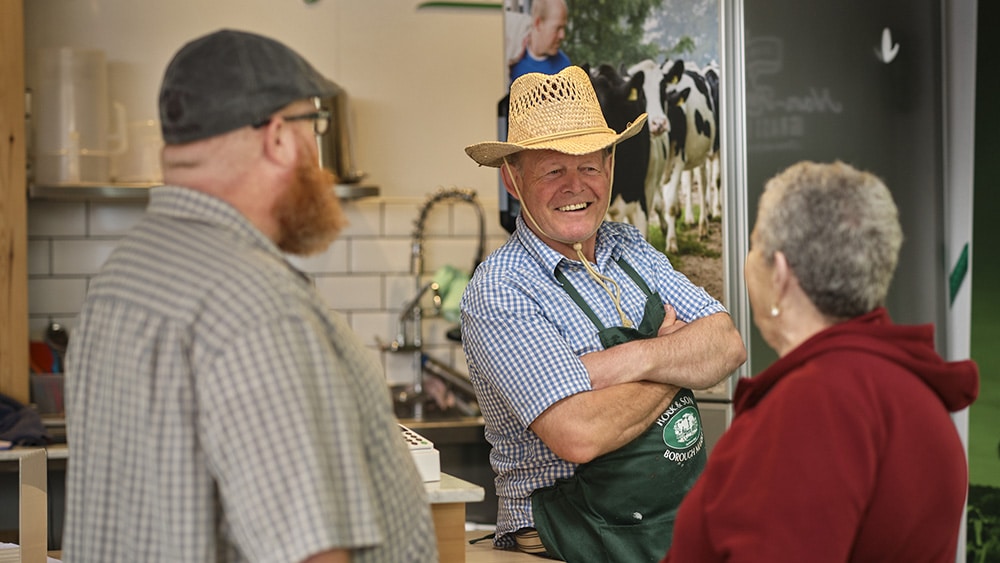
For Dawn, much of the joy of her early experiences at Borough resided in the realisation that this was a very different market to the ones her grandmother had hauled her to. “Oh, it was totally different to Coronation,” she hoots. Significantly, that difference occasioned a sense of discovery and interaction with foods that this young Jamaican woman – who would once insist on having all the peas picked out of her Sunday rice and peas – had never previously encountered. “One awakening for me was truffles,” she explains. “I’ve seen people walk by and say: ‘What’s that horrible smell?’ But, for me, I love a fresh truffle shaved on pasta; I love learning about different cheeses. Being here has been a learning experience.”
This transformative exposure to new, previously unknown culinary pleasures feels familiar to me. By the time I was in my early 20s – increasingly obsessed with kitchen experimentation and TV chefs like Jamie Oliver – my relationship with markets had shifted alongside my general relationship with food. Age brought agency. And so, relieved of the psychological baggage of those childhood expeditions with my mother, I was able to see different markets in a fresh, alluring light. Plantains and warm loaves of Percy Ingle bread from Deptford; golden, delicate girolle mushrooms from stalls in Brockley; the hurriedly devoured prize of a Brindisa chorizo roll at Borough itself. The more I fell down the rabbit hole of gastronomic obsession, the more I appreciated the collision of cultures and the sense of community that gives a good market its crackling energy.
Dawn has felt this too – whether it’s going for a recuperative, end-of-the-day drink with fellow traders, or customers letting her know that Pimento Hill’s chilli jams and curds are particularly good muddled into certain cocktails. Stephen, meanwhile, notes that Borough Market’s multiculturalism has shaped and defined a business that now produces everything from raw ghee to raw buttermilk. “The beauty of a market in London is that there are so many cultures, so many different people,” he says. “Somebody from Poland or South Africa or India buys our milk and I’ll ask them why they’re buying it. Sometimes it’s to sour it or turn it into yoghurt. We get all these little gems that show us how important all this is. Not just as food but in terms of a belief and a culture.”
Places like Borough Market, then, track how neighbourhoods and communities evolve, interact and exchange ideas. But, perhaps more than that, they mark how we grow as people and eaters. “I do get very reflective,” says Dawn. “Because I think, oh my god, if my grandmother could see me working at a market now, her jaw would drop to the floor.”
Picky by Jimi Famurewa (Hodder & Stoughton, £20) is available now
Close to the source
How Borough Market traders look to each other’s stalls for ingredients and inspiration
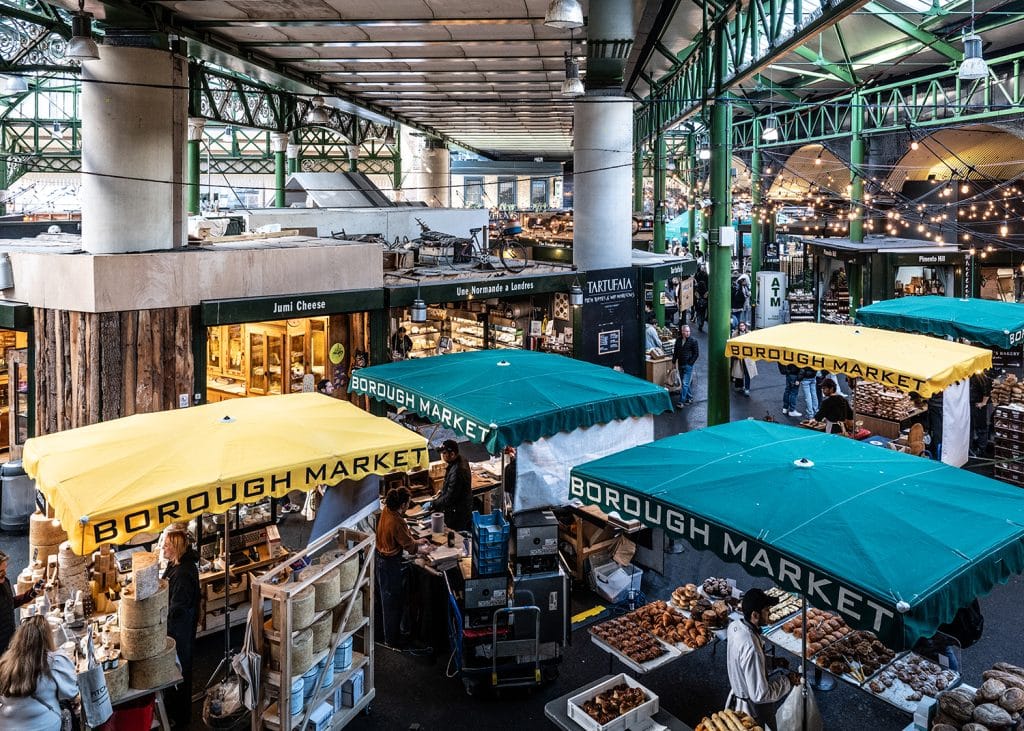

“WE LOVE BEING ABLE TO SUPPORT FELLOW TRADERS – IT’S ABOUT THE MARKET COMMUNITY AND GIVING BACK TO EACH OTHER”
Words: Tomé Morrissy-Swan
For any chef, the route to a great dish starts with the produce. Sourcing the finest marbled beef, the ripest summer tomatoes or crispest winter radicchio is as important as how the ingredient is treated once it reaches the kitchen. Cooks painstakingly cultivate relationships with suppliers, hoping for access to the best fish landed that very day, or the first choice of a batch of an artisan cheese.
Those working in Borough Market’s many outlets are therefore blessed with instant access to some of the country’s finest food suppliers right on their doorstep. For Cathal O’Malley, founder of Oroshi, a Japanese street food stand in the Borough Market Kitchen specialising in robatayaki skewers and bento boxes, “it’s like having the best supermarket in the world” within seconds of his site.
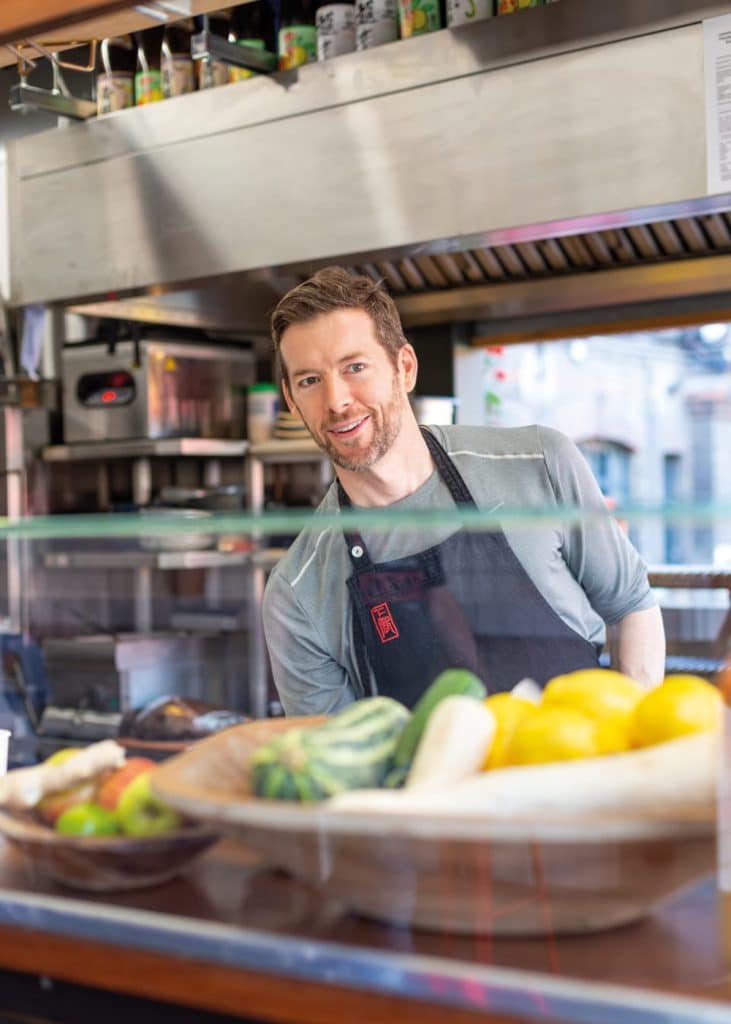
At Oroshi, customers tuck into the likes of venison or mackerel ramen, beef tongue skewers and pork belly bento boxes, which Cathal has been serving at Borough for over five years. Previously head chef at The 10 Cases, a wine bar in Covent Garden, he shifted from his background in French food to Japanese while working at Dinings SW3, a renowned restaurant in Chelsea. At Oroshi, he is taking that knowledge and applying it to the robata grill, providing a restaurant experience within a street food setting.
“One part of the brief was that food should be seasonal where possible, and you should use traders in the market,” Cathal explains of his arrival at Borough. That led him to seek some of the market’s top traders. For seafood, that’s Shellseekers Fish & Game. “I go and choose my own fish in the morning. If I’m using mackerel, I’ll go over and check the quality, the same with salmon.” Cultivating close relationships means some suppliers will keep ingredients back for him, he continues.
At Stark’s Fruiterers, Cathal sources asparagus and pumpkin. “If you go to a good greengrocer, you’re going to get more ideas about what’s going to be good and go well together. Being in the market and able to do that with what’s in season, the flavours tend to be better. The people in the market can tell you what’s good, what’s coming in next week, they have the knowledge.”
Over at Greedy Goat, Josie Wells makes a very different product yet is equally committed to the market’s bounty. Josie produces award-winning ice cream with milk from goats reared by Richard Haskett at Homestead Farm in Dorset. Made on the farm with milk collected that very morning, before being transported to southeast London, Greedy Goat’s ice creams have become a hit with visitors to Borough, with classics like vanilla and honeycomb, or inventions like cherry bakewell or banana chocolate and caramel, a take on banoffee pie, selling like hotcakes.
“I always wanted it to be seasonal, following the seasons, the weather,” Josie explains. “I always wanted to buy British. We’re lucky we’re in Dorset, with an abundance of fruit farms, and there’s so much in the hedgerows around us that we use a lot of our own stuff on the farm.”

But Josie’s foraging extends beyond the hedgerows to the urban environs of Borough Market. That might be permanent ingredients, like pistachios and hazelnuts from Food & Forest, but frequently takes the form of collaborations, which Josie describes as “so fun”. Last year, for example, she created a hot cross bun ice cream around Easter, using unsold buns from Comptoir Bakery. “Not only was it delicious, it sold out in three days. What’s fantastic is that it’s circular, minimising food waste.”
For its part, Comptoir Bakery, which bakes all its bread on nearby Maltby Street, sources coffee from Monmouth Coffee Company, pork and beef mince from Northfield Farm and seasonal fruits from Stark’s. “We love being able to support fellow traders – it’s all about the market community and giving back to each other,” says general manager Holly Wells, who happens to be Josie’s sister. “We talk directly to the supplier, finding ways to help each other. We have very good relationships with our fellow traders, which is good for business and something we place a high value on.”
Back at Greedy Goat, Josie creates seasonal fruit flavours, making the most of any gluts. When 13 Acre Orchard had an abundance of English plums, she turned them into sticky plum and ginger ice cream. “They couldn’t sell the plums quickly enough. I was able to cook them down, freeze it, then add it to the ice cream when I was ready. Working with traders is all about being creative but also the opportunity to reduce waste, which has been super cool.”
As for the traders, “they love it,” says Josie. “The wonderful thing about Borough Market is it’s such a community; everyone loves being able to help and be part of each other’s growth. They’re also excited to see how the collaborations turn out.”
Cathal agrees: “There’s a community vibe, very much so. In the market you’ve got so many traders from all over, bringing their skills and attitude, and they are very helpful to each other.”
Earlier this month Josie put on a marmalade on toast ice cream special using brown bread and blood oranges from The Flour Station and Stark’s. It quickly sold out. “Ice cream has endless possibilities about what you can make. Any flavour can be made into ice cream – and that’s the wonderful thing about Borough Market: there’s so much to choose from.”
A punnet of sunshine
How the welcome arrival of English berries and cherries sounds the bell on the start of summer
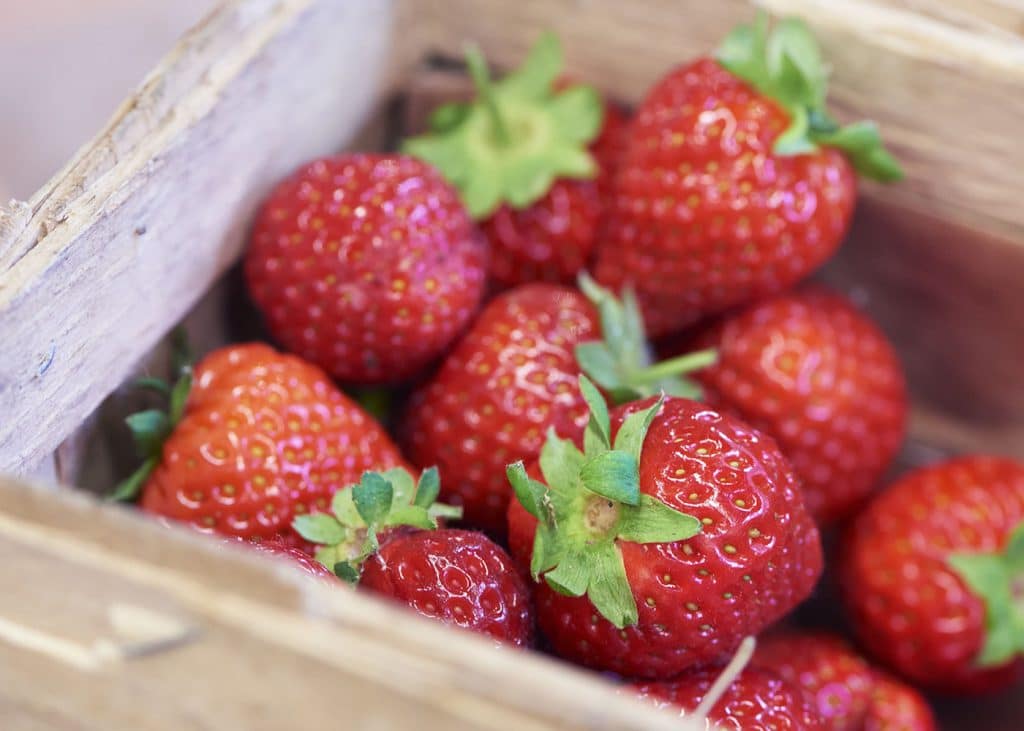

“WE FORGET QUITE HOW SWEET AND ZINGY ENGLISH BERRIES TASTE WHEN THEY’VE HAD TIME TO RIPEN IN THE SUMMER SUNSHINE”
Words: Thea Everett
The arrival of British berries is as important a symbol of the start of summer as the solstice or the first night of Glastonbury. When Kentish strawberries and cherries arrive on market stalls, you know that the season of lager tops, international football and park picnics is upon us.
But I’ve noticed a bit of favouritism going on when it comes to seasonal fruits. When forced rhubarb (okay, a vegetable technically) and blood oranges appear in January and February, the world goes mad. Instagram turns candy pink for two months, as do the display cabinets and dessert menus of bakeries and restaurants. The same is true when it comes to Indian mangoes in April and May. Boxes of these fruits become prized possessions and mango recipes are all over social media.
So why not the same passion when it comes to British-grown summer berries and cherries? Just because they’re familiar to us, and they’ve always been there, doesn’t mean they don’t warrant a party of their own. The problem, I suppose, is that summer’s wealth of produce – from watermelons and peaches to tomatoes and peppers – can mean that exciting ingredients get lost in the crowd. We’re also so used to the insipid year-round strawberries sold in the supermarket that we forget quite how sweet and zingy they taste when they’re locally grown and have had time to ripen in the summer sunshine.
The truth is that a fantastically juicy, pillar-box-red strawberry is as special as a fruit can get. And a deep crimson cherry grown in Kent is just as satisfying a treat. They’re gorgeous to behold and a delight to eat and it’s high time we championed these seasonal British fruits.
The virtues of the British berry season are many: they’re grown locally, without the attendant air miles, so when you buy a punnet, you can be sure your fruit will be the freshest possible. Summer is when berries and cherries are at their most plentiful and the peak of their flavour, so it pays to eat them now. Their abundance also means they’re ripe for preserving in jams, syrups, chutneys and drinks.
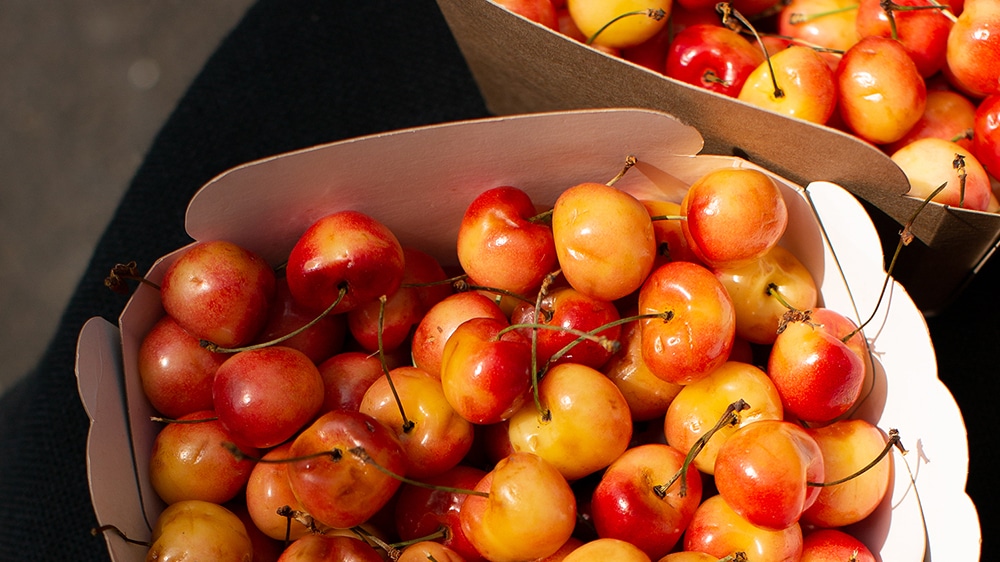
Though the simple strawberry needs nothing more than a dousing of double or single cream, there are so many ways to make the most of this beautiful British fruit. Eton mess or trifle are all well and good, but my chocolate cream and strawberry pie is undeniably more exciting, and far simpler to make than it looks. Made with a two-step ganache and no-bake biscuit crust, it’s the ideal heatwave dessert that takes the classic combinations of strawberries and cream and strawberries and chocolate and turns them into an almighty centrepiece. Think the impressiveness of chocolate cream pie or banoffee pie, but less of the work.
As for cherries, other countries tend to be good at celebrating their magnificence: the American cherry pie, the German black forest gateau and the French clafoutis. But sadly when it comes to British recipes featuring cherries the glacé variety seems to reign supreme. When cherries as good as those you’ll find at Borough’s greengrocers are grown on our shores, it seems a crime not to give them time and devotion in the kitchen. So I urge you to make cherries a main event this summer. I hope my cherry and ricotta galette might convince you: nutty rye pastry is topped with lemon-scented ricotta and fresh cherries macerated with sugar which bake into a gorgeous purple pie. Pitting (try using a chopstick!) and then layering up the sliced cherries for the topping is a very therapeutic way to spend an afternoon, let me tell you.
Cherries are also brilliant in savoury cooking. Like apples and peaches, they pair so well with pork. In my recipe for pork chops with cherry sauce, I’ve turned them into a lovely sauce with that other summer staple: rosé wine. It’s an easy weeknight winner that makes your simple chop feel restaurant-worthy, offering a deeply sweet accompaniment that complements the meat’s saltiness perfectly. The sauce would also be lovely alongside roast duck, venison or pork shoulder should you want a summertime twist for your traditional Sunday roast.
And then there are drinks. Nancy Sinatra and Lee Hazlewood got it right in their 1967 hit Summer Wine, which conjured up the beauty of these fruits in all their hazy summery glory: “Strawberries, cherries and an angel’s kiss in spring / My summer wine is really made from all these things” – as good a reminder as any that introducing summer fruits to your next cocktail or glass of fizz is never a bad idea.
So think pink and see red this summer! Stain your fingers fuchsia and reap the rewards of buying local and seasonal when it counts.
Explore Thea’s recipes
Edible histories: the full English breakfast
Mark Riddaway, author of Borough Market: Edible Histories, tells the surprising story of one of the country’s defining dishes
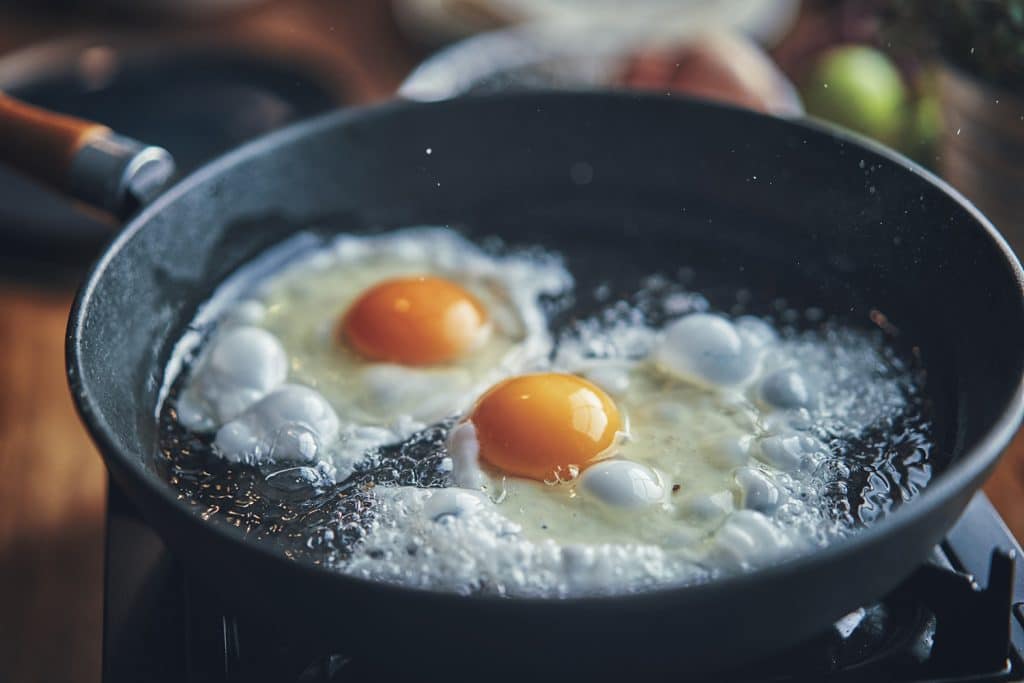

“A COOKED BREAKFAST MANAGES TO TRANSCEND SOCIAL CLASS IN A WAY THAT FEW OTHER ENGLISH FOODS EVER WILL”
Words: Mark Riddaway
It’s hard to trust a single word written by Kenelm Digby, one of the more colourful characters in the history of food writing. Lying was, it was said, “his infirmity”. Did he really fake his own death to avoid sleeping with the King of France’s mum? Did he really kill a man on a Paris street? Did the ‘powder of sympathy’ gifted to him by a mysterious monk really heal wounds from a distance? Questionable at best. One of Digby’s claims is, however, irrefutable. “Two poched eggs with a few fine dry-fryed collops of pure bacon are not bad for break-fast,” he wrote in a recipe collection published in 1669. And very few among us have since found cause to argue.
Eggs and bacon are the twin pillars of the full English breakfast – a world-famous dish that manages to be both universally familiar and impossible to define without sparking a row (let’s go with the 1964 US Supreme Court test for obscenity: “I know it when I see it”). The inhabitants of these islands have been breeding pigs and chickens, curing bacon, stuffing sausages and turning blood into black pudding since long before ‘England’ was even a thing, so our affinity for salty, fatty pork mopped through a slick of golden yolk has deep roots. But the idea of consuming them first thing in the morning is fairly new. When it came to matters of breakfast, Kenelm Digby was ahead of his time.
In medieval England, the national breakfast was nothing like the bulky fry-up of our collective imagination. For most people, the first meal of the day (usually eaten late in the morning after several hours out in the fields) consisted of bread, porridge or gruel, washed down with weak ale: cheap fuel for grinding labour. As towns and cities grew, creating jobs that dragged workers away from the home, breakfast shifted back to the start of the day. Still, though, the bacon-and-eggs era was a distance away. For example, the breakfasts recorded in Samuel Pepys’s diaries in the 1660s consisted mainly of random leftovers, plus an array of foods ranging from mince pies to radishes, with just a single mention of eggs. It wasn’t until the 18th and 19th centuries that a more expansive, protein-heavy take on breakfast began to take shape – and for all the apparent earthiness of a full English, it did so in the vast kitchens of the moneyed elite. Like brown sauce from a crusty bottle, it glooped down very slowly from there.
For most of our history, only the rich have had the means to enjoy meat and eggs on a regular basis. As the industrial revolution and Britain’s growing empire made the rich richer and more numerous, spectacular multi-dish breakfasts became an important signifier of status. In Imperial England, if you didn’t have dozens of plates, a dedicated ‘breakfast room’ to serve them in and a battery of servants rising at 4am to prepare them from scratch, who even were you?
Eggs and bacon are present in just about every description of these sprawling country house breakfasts, as are many other elements of the modern full English: sausages, mushrooms and lots of buttered toast, each golden slice crisped to perfection on the end of a toasting fork. But alongside them, and afforded equal importance, are a bewildering list of other dishes. Always several fish – mackerel, whiting, herring. Probably some sheep’s kidneys, veal pies and collared pig’s face. An entire table of cold joints: ham, tongue, beef, poultry. In Georgiana Hill’s The Breakfast Book (1865), the long list of “things most commonly served” includes bloaters, brain cakes, devilled bones, caviar and curries.

What’s notable about many of these dishes is their contrast to the fussy Gallic refinement of an aristocrat’s evening fare. These were solid, substantial foods; an expression of Victorian English virtues: plain, robust, not in any way feminine or French – the culinary equivalent of a cold bath, a violent ball sport or an early morning hunt; the kind of food that a true man of the empire needed in his stomach, ready for a hard day of exploiting the poor.
Cajoled by the likes of Mrs Beeton’s kajillion-selling Book of Household Management, Britain’s growing middle class aspired to the ways of the country house set – and that meant breaking the fast with something grander than bread or porridge. But if you didn’t have a vast kitchen, a dedicated breakfast room and a battery of servants, and if the man of the house had to be at work for 9am, you might have to edit things down a bit. Bacon, eggs, sausages, mushrooms and toast (especially after the invention of the toaster in the early 1900s) all had the benefit of being easy to cook on a small domestic stove but still suggestive of a certain status. Gradually, the fried breakfast in its more limited form began to establish a presence everywhere from grand hotels and public-school refectories to factory canteens and cheap boarding houses. Lodging in a grotty Wigan terrace in 1936, George Orwell was fed “two rashers of bacon and a pale fried egg, and bread-and-butter which had often been cut overnight and always had thumbmarks on it”. Mrs Beeton would have shuddered.
Snobbish cookery writers, aghast at corners being cut, wailed at the shunning of sweetbreads, cod’s roe and fricasseed fowl. As Colonel Arthur Kenney Herbert wrote in the introduction to Fifty Breakfasts (1894): “The ding-dong monotony of ‘bacon and eggs’ alternated with ‘eggs and bacon’ of many English breakfast tables is wholly inexcusable.” That monotony was finally broken by the Second World War, but not in a good way, as strict rationing of bacon and eggs condemned us once again to be a nation of porridge eaters. As Ambrose Heath reported in Good Breakfasts (1940): “The lack of bacon has disturbed our native breakfast dish and brought doubt and distress into many an early morning kitchen.” Forget the Blitz – this was the true national crisis.
The end of rationing in the 1950s after more than a decade of restrictions coincided with significant social change. The rapid industrialisation of food production, plus a marked narrowing of wealth inequality (since dramatically reversed), meant that cooking the odd lavish fry-up at home, or even eating out for breakfast, became a plausible option for just about everyone. Market cafes, transport caffs, 24-hour diners and other ‘greasy spoon’ establishments (an expression that, like the squeezy bottles of ketchup on their nailed-down tables, was – sad to report – an American import) sprang up in every town, offering strong tea, fast service and gut-busting breakfasts. The challenge of the full English is that so many components need to come together at once. At home, bacon, egg and toast might bring you close to capacity. But eating out, you could go the full hog, quite literally.
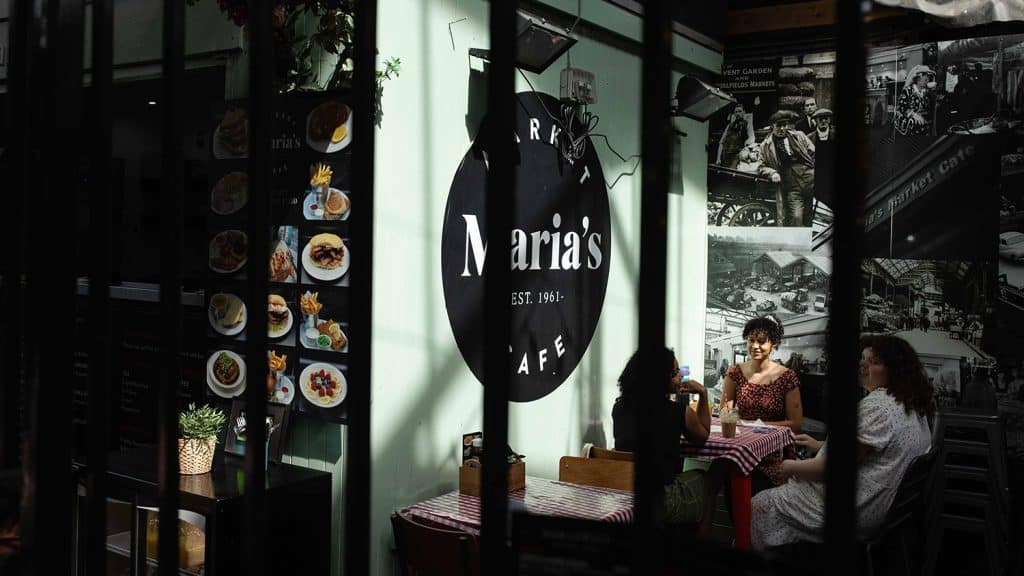
In these cafes, elements that had no precedent within the breakfast feasts of the Victorian elite began to find their place on the plate. Fried potatoes, fried bread and bubble and squeak added breadth and ballast while also using up the previous day’s leftovers. Baked beans also forced themselves into the reckoning. Heinz beans, imported from America, had initially been sold at Fortnum & Mason in 1901 as a luxury food, but after the first British-made beans rolled off the new Heinz production line in Harlesden in 1928, had embedded themselves as a cheap, convenient staple of working class kitchens and a popular addition to the fry-up, adding lubrication and much-needed fibre to the piles of fatty meat.
One of the ironies inherent to the unstoppable march of the English breakfast was that, particularly in big cities, the greasy spoons that drove its booming popularity were often owned and run by people whose cultural heritage lay far beyond England – primarily Italians, Cypriots and Turks, but also many Bangladeshis and Chinese. Maria’s Market Cafe at Borough Market, one of the true survivors of the golden age of the caff, was one of the many London establishments with Italian roots. After moving to the capital in the early 1960s, the Moruzzi family opened the Borough Cafe on Park Street. The market back then was a vast fruit and veg wholesale operation staffed by hundreds of burly porters, and many of the cafe’s regulars would be coming off a night shift, proving that a full English doesn’t have to be the first meal of the working day – it can also be the last. Under the management of Maria Moruzzi, the cafe that now bears her name moved to the heart of the revitalised retail market in 2012. Maria retired in 2021 with more than 50 years of service under her apron, but the Moruzzi legacy lives on in a classic full English breakfast still redolent of Borough Market’s past.
With a clientele that ranges from City executives to delivery drivers, Maria’s embodies the ability of a cooked breakfast to transcend social class in a way that few other English foods ever will. Depending on the setting, a full English can express the country-house grandeur that birthed it or the post-war populism that made it universal. You can buy one for £56 at The Ritz or a fraction of that at Maria’s (with no compromise on quality). You can argue about black pudding or baked beans or whatever bugbear you happen to hold. But whatever your choices, you’ll grasp one of the truths that bind this nation tight: that two eggs with a few fine dry-fried rashers of bacon (plus three or four other elements) are not bad for breakfast.
Borough Market: Edible Histories by Mark Riddaway (Hodder & Stoughton) is available now from The Borough Market Store, in bookshops and online.
Five steps to a perfect picnic
Gurdeep Loyal’s failsafe formula for filling a picnic basket at Borough Market


“THERE ARE FEW THINGS MORE CHEERING THAN THE CONTENTS OF A PICNIC HAMPER SPREAD OUT OVER A BLANKET”
Words: Gurdeep Loyal / Images: Stuart Ovenden
Eating alfresco in the summer months is one of life’s true joys. There are few things more cheering than the contents of a picnic hamper spread out over a blanket on a sunny patch of grass somewhere in the city. While you can’t always count on the weather, picking up provisions from Borough Market guarantees that your outdoor feast will be a riot of summery flavours, craftmanship and epicurean storytelling. Here’s my failsafe five-step formula for the perfect picnic – even if you end up devouring it under an umbrella!
The rippled loaded dip
Every good picnic needs a dip. Hummus, taramasalata and tzatziki are eternal classics, and whipped feta is all the rage this year. But for something fresher and brighter, try a dip with a base of blitzed summer vegetables and toasted seeds. My vegan recipe for pea, artichoke & pumpkin seed dip with a preserved lemon ripple is just the ticket.
13 Acre Orchard’s Italian globe artichokes are ideal for this, with their bright ombre purple-green leaves and thick stalks – be sure to boil them in plenty of well-salted water to bring out their delicate earthy flavour. Borough’s greengrocers are also great for seasonal crudities: purple carrots, nobbled ridge cucumbers, bright yellow Italian peppers, purple chicory, red radishes. You’ll also find a cornucopia of fresh herbs to blend into the dip – dill and mint will evoke the Middle East, fresh basil and oregano the Mediterranean, or tarragon and chives the English summer garden. For something more unusual, you could even try red-veined sorrel or aniseedy chervil.
In my recipe, a hit of flavour comes from preserved lemon from Arabica and From Field and Flower’s raw Devon flower honey, rippled through the vegetal pastel green dip. Alternatively, head to Raya for chilli sauces, oils and pastes, Borough Olives for fiery red harissa or Moroccan chermoula, or The Olive Oil Co for a tangy fruit vinegar.
Pea, artichoke & pumpkin seed dip
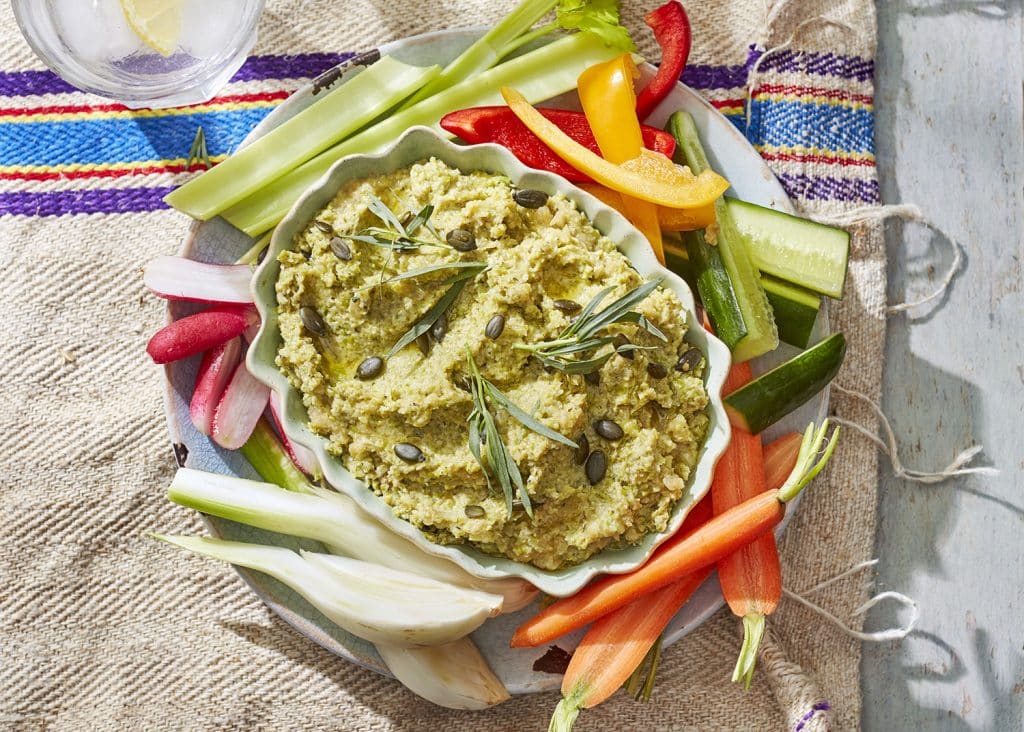
The flavour-amplified sandwich
A dainty crustless finger sandwich with good butter and wafer-thin cucumbers certainly has its place – but a joyful summer picnic is not it. Alfresco dining demands a deep-filled sandwich grabbed with both hands. Perfect for this task is my sourdough muffaletta – a whole-loaf sandwich with roots in New Orleans.
To start, you need a good sturdy loaf. Olivier’s Bakery’s pain de campagne is wonderful – a crusty sourdough made with a mix of white and rye flour. Their earthy London City Rye would also be great, with its earthy interior and delicious dark crust, as would Artisan Foods’ seedy white sourdough with linseeds, sesame and sunflower seeds.
Italian deli meats are essential, for which The Parma Ham & Mozzarella Stand is a great place to start – try their smoky-savoury speck or rich, nutty prosciutto di Parma. A flavoured salami or mortadella also makes a great addition, and for me it has to be salami finocchiona, enriched with fragrant fennel seeds. For Italian cheeses head to Gastronomica Market. You want a mix of something creamy and grassy like a mozzarella di bufala, and something sharp or smoky like a Puglian smoked scamorza.
Also essential are some tangy-briny condiments. De Calabria’s sundried tomatoes in oil are a classic. Borough Olives’ green pitted olives with parsley, tarragon, garlic and lemon juice are fantastically vibrant, while their plump cornichons are tangy with vinegar and mustard seeds, and their green pesto is unbeatable – another burst of flavour. A final addition is a layer of roasted red peppers – Brindisa’s cans of piquillo pepper strips offer a potent sweetness.
Sourdough muffaletta
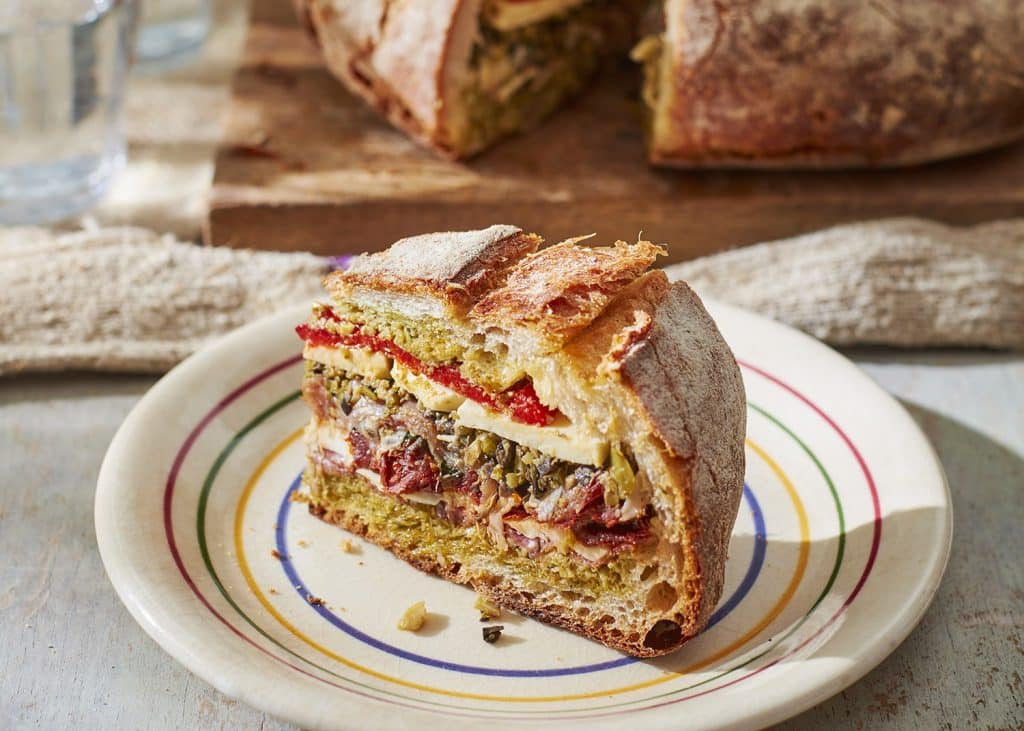
The show-stopping savoury bake
Whether perched on the dainty cake stand or plonked onto some brown parchment in the middle of a rug, a quiche or savoury tart is essential. Classic deep-filled quiche Lorraine with gruyère and bacon is having something of a comeback. Or try a pork and stilton pie from Mrs King’s Pork Pies – water-crust pastry filled with outdoor-bred pork shoulder, cheese and white pepper.
But for a taste of something a little more continental, look to France – a nation that nails the savoury picnic bake every time. There’s the classic Niçois pissaladière – an onion tart crossed with anchovies and olives; the Marseille-style pizza, topped with heirloom tomatoes, soft goat’s cheese and an abundance of herbs; or the flamiche from Picardy – a pizza-quiche hybrid with slow-cooked leeks, cheese, creme fraiche and eggs. My recipe for a tomato & anchovy pissaladière flamiche combines the best elements of all three and shows off some exceptional Borough produce.
One of its main ingredients is slow-cooked onions, for which Le Marché du Quartier has just the thing – their hanging tower of new-harvest French onions, including Roscoff pink onions, red onions and shallots. A combination of strong cheeses is also essential and Jumi Cheese’s gruyère or Grandfather Schloss are particularly delicious. Add to this a sharp parmesan, like the 24-month Tortiano parmesan available in generous chunks at Borough Cheese Company. You’ll be combining the cheeses with eggs (try the Chapel Farm eggs from Wyndham House Poultry) and creme fraiche, for which Hook & Son is the place to head. To top your tart, you’ll want good flavourful tomatoes and an abundance of anchovies, both of which are in plentiful supply.
Tomato & anchovy pissaladière flamiche
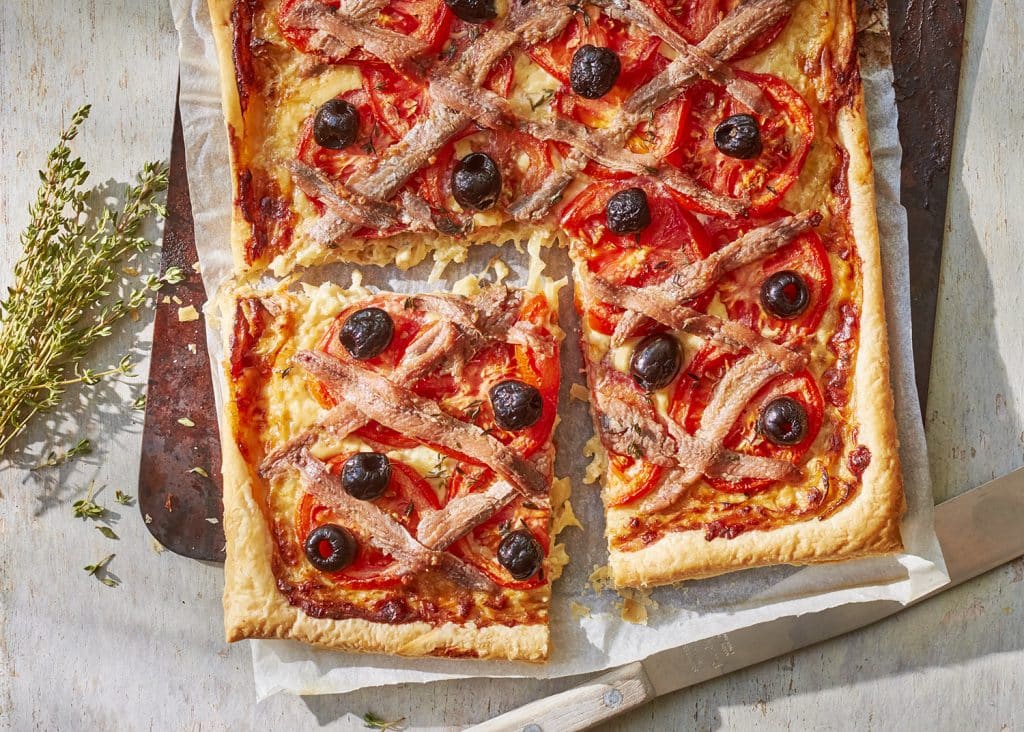
The four c’s: cheese, chutney, charcuterie & crisps!
For cheeses, you don’t need to go overboard – two or three is perfect. Try a fresh semi-soft cheese, a strong hard cheese like Pitchfork Cheddar from Trethowan Brothers, and then a blue like the heavenly 1924 by Fromagerie Laqueuille, available at Mons Cheesemongers. Chutneys from Pimento Hill always pair brilliantly with cheese – scotch bonnet chilli jam, hot banana chutney or tangerine marmalade, which is exceptional with a blue. I would throw in some of Brindisa’s jamón Ibérico, smoky pimenton-infused Ibérico chorizo, or rich salchichon de Vic, which has a deep flavour enlivened with whole black peppercorns. Brindisa is also the place to go for good crisps.
The sparkling summer tipple
The best picnic should leave you feeling fizzy with summery sunshine, which often also means leaving full of fizz – for which Cartwright Brothers Vintners is a good place to go. Their Beato Bartolomeo Breganze prosecco, a classic summer tipple, is also delicious in a summer spritz. As an alternative to champagne, try the English Davenport Limney Estate Brut, and for a sparkling rosé, the Rosa di Sera Vino Spumante is perfect for quaffing in a park.
Quite the catch
Jack Applebee, CEO of the recently relaunched Applebee’s seafood restaurant, on sourcing directly from fisheries, working with family, and finding the balance between classics and creativity
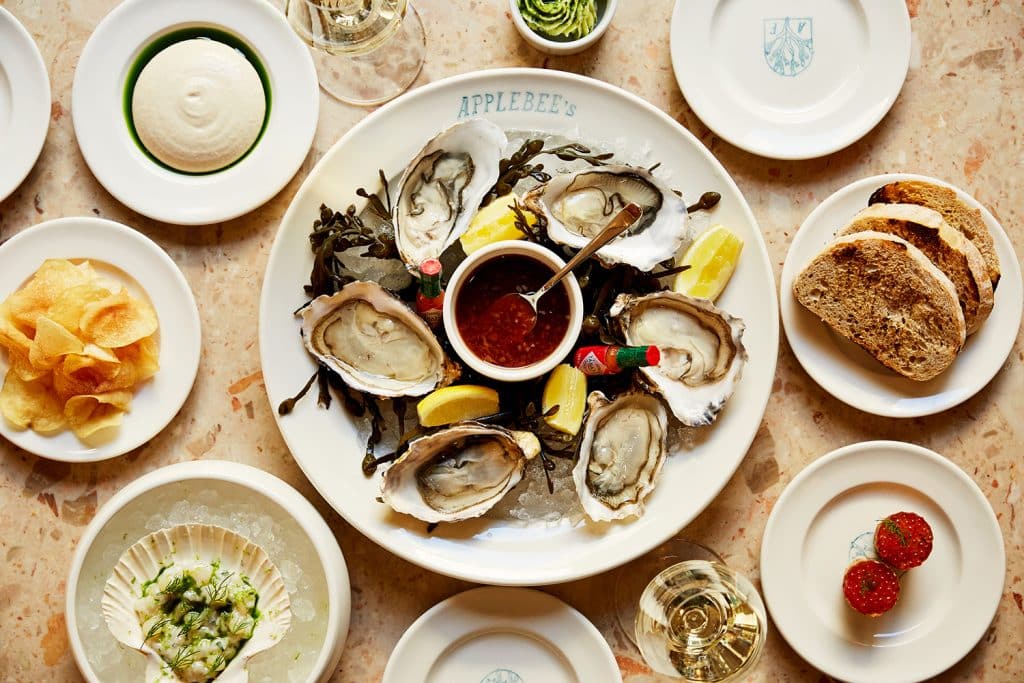

“WE WANT TO DO THE CLASSICS REALLY WELL BUT GIVE THE CHEFS LICENCE TO DO THINGS THEY’RE PASSIONATE ABOUT”
Words: Tomé Morrissy-Swan / Images: Matthew Hague
Every day at Applebee’s, one of the team is up by 6am, ready for an online auction from Brixham Market in Devon. Bids fly in for fish landed that very same morning. Those fish will arrive in SE1 within 24 hours.
“It gives us the best produce at the best price, it’s a huge win for everyone,” says Jack Applebee, the restaurant’s CEO. “Operationally, it’s quite difficult. You don’t know what you’re going to get – it’s the law of the sea really. Hake, for example: one week a month the tides are wrong, and they can’t catch it.” But this approach is harder than simply going via a wholesaler, it means the restaurant can offer the best, freshest and most seasonal fish at the best value possible.
Applebee’s had a glamorous relaunch this February, offering a more “refined” take on a seafood restaurant, says Jack. Borough Market’s cadre of restaurants has earned renown of late, from the newly Michelin-starred Oma to Cynthia Shanmugalingam’s Rambutan. Now it has a seafood restaurant to match – one rooted in classic British and French cooking, elevated by modern creativity and flare.
A butterflied mullet comes swimming in a delicate bouillabaisse sauce. A whole stuffed sea bream is expertly cooked, flesh pearlescent and flaky, stuffed with spicy potatoes and surrounded by excellent curry sauce. On today’s specials board, a dry-aged dover sole meunière is one of the best examples you’ll find anywhere in London, with a beautiful butter, caper and brown shrimp sauce. The cooking from executive chef Frankie van Loo, who recently joined after several years working for Jason Atherton, is superb.

Applebee’s was one of the original Borough Market traders, opening in 1999 when the market was reborn in its current guise. Jack’s parents, Joy and Graham, began as fishmongers then set up a street food operation a few years later, as the market increasingly began to cater to those seeking cooked food. Jack joined in 2015, aged 22, by which time Applebee’s was primarily a restaurant, having opened in its current Stoney Street location just before the 2008 financial crash. “It seemed wise to double down on the restaurant side rather than pushing the fishmonger’s,” says Jack. “I’d love to revitalise the fishmonger’s, but it’s difficult to operate as a full-blown fishmonger with a restaurant operation.”
The ethos has always been the same: the best and freshest British seafood. Around 85 percent of the produce sourced by the restaurant is British, and the majority of the fish comes from Cornwall and Devon. By cutting out middlemen, Jack believes Applebee’s is able to offer good value while keeping the supply chain short and transparent. “We’re just doing what we can to keep the prices as sensible as possible. When you buy seafood through intermediates rather than going direct, you’re in the hands of someone, and you don’t really know the journey of the fish,” says Jack, who points out sourcing this way can result in fish that’s several days old by the time it reaches the diner’s plate.
Running a Borough Market restaurant is a unique experience in London, says Jack, who founded the family’s sister operation, a Spanish tapas restaurant called La Gamba on the Southbank, in 2023. Applebee’s location attracts a blend of regulars, office workers, hardcore foodies and tourists. The menu reflects that, mixing the likes of grilled monkfish tail and tranche of turbot with British favourites including fish and chips and fish pie.
“We’re still trying to work out the balance,” Jack explains. “We want something we’re proud of. Any of the classics we do, we try to make the best you can have. The best fish and chips, the best dover sole meunière. We’re not super traditional, but we are traditional in a way. We’ve been here around 25 years, and we want to do the classics really well but to give the chefs creative licence to do things they’re really passionate about.”
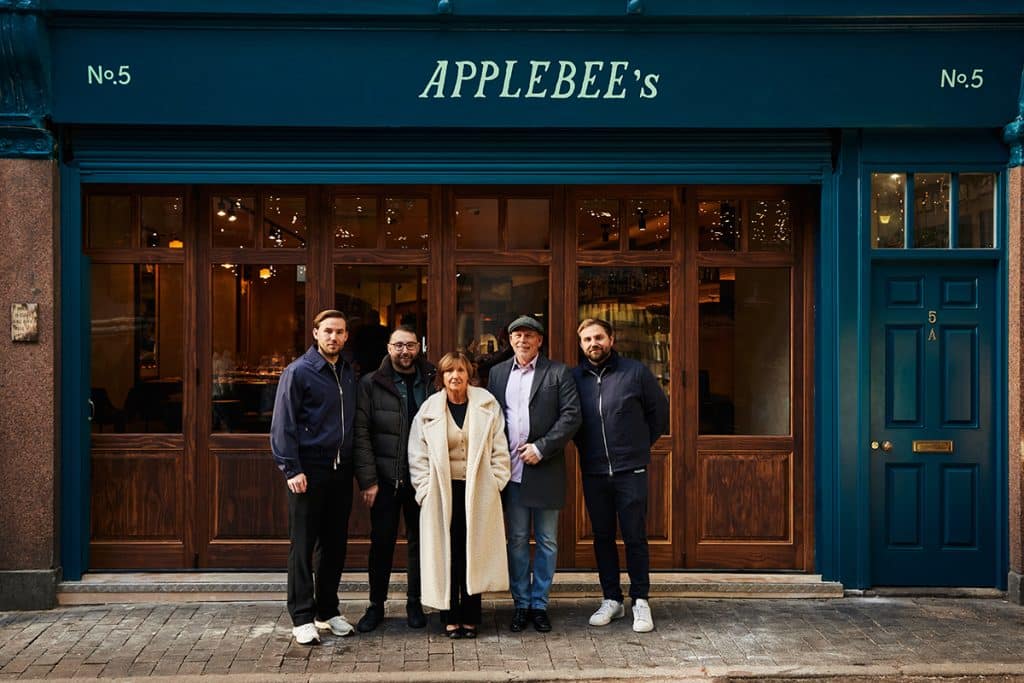
Despite its newly smartened site (Applebee’s still runs a seafood hut in the market selling more casual grab-and-go dishes) it remains a family affair. Joy does the accounts, Jack’s brother Harry is one of the restaurant’s fishmongers, and another brother, Matt, is the general manager at La Gamba. Two cousins currently work at Applebee’s. “If someone needs a job, we’re always there for them. I can’t think of a member of our family who hasn’t worked for us at least a day.”
In the coming months, Jack hopes to push lesser-known species. Britons are relatively unadventurous when it comes to seafood, especially compared with our Mediterranean counterparts. That wonderful bouillabaisse sauce is made with red mullet and gurnard, two underappreciated species the latter of which Jack is particularly keen to push. “We would love people to know what a gurnard is and want to order it. We want to bring in gurnard, whiting, things people don’t order much but can be really good. We want to educate people, slowly but surely.”
He hopes to change the menus frequently, with monthly tweaks. While the specials board will highlight the best seasonal fish based on what has been caught the day before. “If we see really good value turbot or john dory, we’re going to buy it. Or mackerel, or red mullet. Being able to do that is fantastic.”
For now, though, Jack is “very happy with how the relaunch has gone. The team has been brilliant in adapting to the changes. We’ve had some amazing feedback from our regulars.” Applebee’s 2.0 is emerging as one of the city’s best seafood restaurants – one set to grace the Borough Market scene for many more years to come.

Grilled dover sole with capers, lemon & beurre noisette
A classic flat fish recipe from Frankie van Loo, the executive chef at Applebee’s
Fish tales
Max Tucker, manager of Furness Fish Markets, on spring fish, careful sourcing, and the importance of communicating with customers
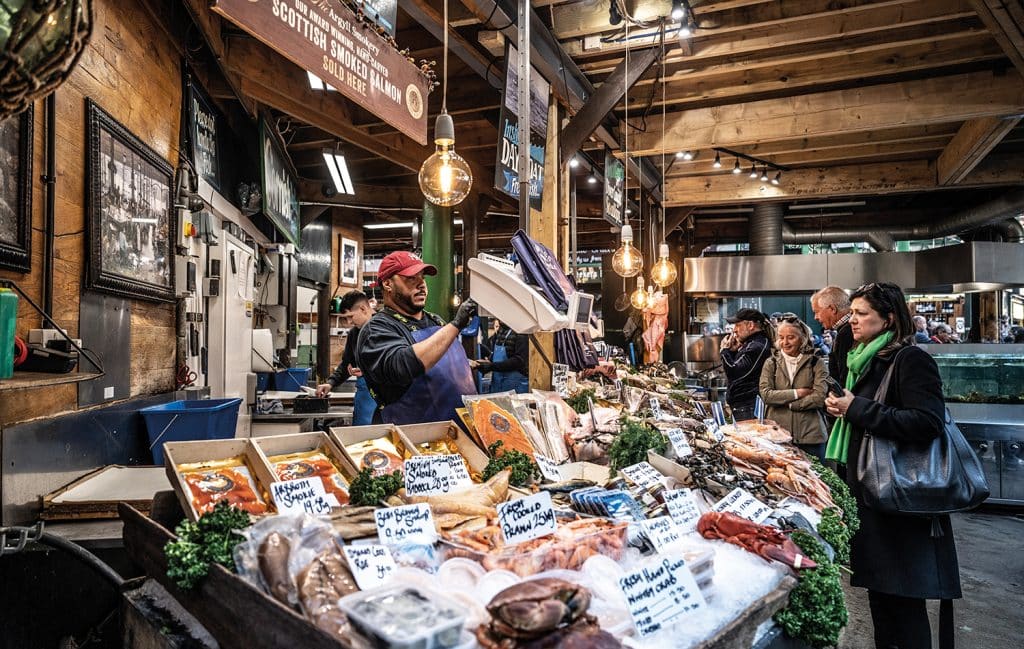

“AS A SMALL BUSINESS, WE’RE ABLE TO WORK ON SOURCING QUALITY OVER QUANTITY, AND THAT’S THE BIG DIFFERENCE”
Interview: Mark Riddaway / Images: Sim Canetty-Clarke, RED Agency
How did you come to be a fishmonger?
I used to run a pub just round the corner from here. It didn’t open at weekends, so I would to come to the market on a Saturday. I’d get some oysters, have a pint of Guinness over in the Market Porter, and just soak it all up. I was always fascinated by the way Les Salisbury, the owner of Furness Fish Markets, used to put his counter out. I’d watch him setting up. It was something I hadn’t seen before – definitely one of the most attractive stands in terms of the colours. I’ve always been interested in fishing – I used to fish as a kid, over at Hampstead Heath. Anyway, my life circumstances changed, and Les ended up offering me a job. That was 20 years ago. The rest is history, as they say.
The fish counter is still a thing of beauty. Who’s responsible for that?
When I first started here, Les wouldn’t let anybody else touch the counter. About 10 years ago he let go of the reins a little bit and handed it over to me. Now I’ve handed it down to one of my guys, Harry. It’s a real art. It’s like a painting: the contrast of colours, textures, different levels of ice, bits of wood, other decoration. It can take anything up to two hours. It’s got a bit more difficult recently because the fish isn’t as cheap as it used to be, so we buy a little more frugally – you can’t afford to waste anything – but we still make it look amazing. It only works because of the quality of the fish, and that comes down to the sourcing. I believe the reason for our success over 20-odd years is that we really do pride ourselves on quality.
How does your approach to sourcing affect the quality of the fish you sell?
It’s all about the process. I remember reading about these big American fisheries that fish for the supermarkets. They catch a load of fish out in the North Atlantic. The boat’s out there fishing for about five days at a time. When they dock, they send the catch off to China to be processed and packed. From there, it’s sent on to a distribution centre in the UK, where they repackage it and send it out again. That can be a 10-day process. By the time it’s on the shelves, that fish is nearly at the end of its life. As a small business, we’re able to work on sourcing quality over quantity, and that’s the big difference. If I’m getting my fish from the Shetland Islands, it’s here in two days.
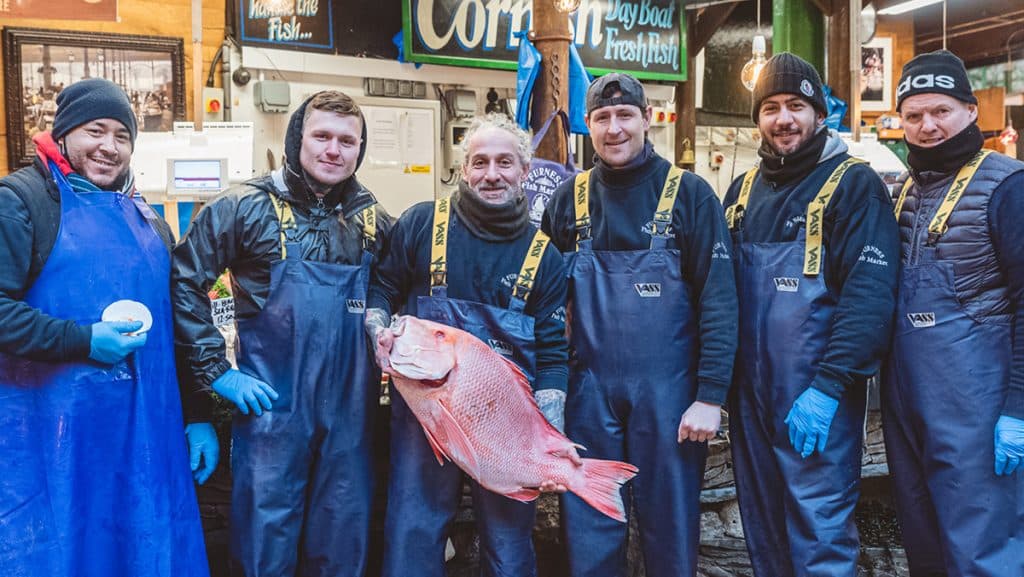
How do you avoid waste?
It’s about getting the ordering right, it’s about the turnover of stock, how you manage your fridge. We’re also blessed with the paella. The last thing I want is for one of our customers to take a piece of fish home, leave it in their fridge for another couple of days and it be no good. At that point, I’ll put it into the paella, so the paella changes from day to day, week to week.
As spring gets underway, what should people be looking out for on the Furness Fish Markets stand?
For me personally, coming into spring and summer, it’s always going to be about sea bass and mackerel. I can’t wait to get my hands on a really nice Cornish day-boat sea bass. Mackerel is also just coming back into season. They migrate twice a year, once for food purposes and once for reproducing. There’s nothing like fresh mackerel. It’s fat, it’s plump, it’s firm. The inside will be grey, almost translucent, not flaky and brown like the pre-filleted stuff you find. For me, there’s nothing better than fresh mackerel chargrilled on a barbecue, so I love it when spring comes around. Brown trout will be coming soon to the counter. That’s amazing. You’re also going to get wild sea trout through May until August. That’s amazing too.
So, do you fillet everything on site?
Yes, we buy whole fish and we fillet here. If you buy fillets in, the quality is terrible. It’s a real skill. When I was young, my mum would say: “You need to get a trade.” Back then, I wouldn’t have thought about this. My dad was a mechanic, my uncle’s an electrician, another uncle works for BT. But this is a trade too. Once you’ve learned it, you can go anywhere in the world and use it. If you can handle a knife, if you can fillet a fish, if you know a bit about fish and fishing, you’ll always find work. I’m in a different role now within the company, so I’m not on the block as much as I used to be, but when I get the chance, I do love it.
There are so few fishmongers left these days. Are some people a little intimidated by what’s on offer?
Our counter can be very daunting for some people. There are certain things we have on here that you’re never going to see in a supermarket. That’s why it’s so important that we talk to people. I’m on at my guys all the time: if someone walks into that shop, you have to engage with them. “How are you doing? Is there anything I can do for you?”
Presumably that means everyone in your team needs to know a lot about preparing and cooking fish.
That’s the business. You have to be able to educate people. You have to know what you’re talking about. If you tell a customer something and they go home and it’s no good, they’re not going to come back.
When I came here, I had no idea about cooking fish. But what I’ve learnt over the years is, it’s so simple. I don’t really season fish – when it’s good, I want to really taste it. A little bit of pepper, a little bit of lemon when it’s cooked, but that’s all you need. It’s the speed as well – you can cook a sea bass fillet in four or five minutes, and you’ve got your dinner ready.
Q&A: James Walters
The founder of Arabica on finding his tribe at Borough Market, his enduring love of eastern Mediterranean cuisine, and the launch of his debut cookbook


“ACROSS THE EASTERN MEDITERRANEAN THERE ARE ALL THESE HUGE CONNECTIONS BUT ALSO INCREDIBLE LOCAL NUANCES”
Interview: Mark Riddaway / Images: Joe Woodhouse
Arabica has been synonymous with Borough Market since 1999, the first full year that a dying wholesale fruit and veg market burst back into life as a magnet for food lovers. Populated by a small community of specialist retail traders, it was, in the words of James Walters, “something we’d not seen before on these shores, something truly magical”.
Among those pioneering early traders was Jad, a warm, charismatic Jordanian man, who came here every Saturday to sell homemade meze and spice blends. James, a young chef, joined him shortly afterwards in an entertainingly offbeat sequence of events that bore zero resemblance to a career plan – and it was James, a roaring turbine of energy and ambition, who become the business’s driving force.
His first restaurant, Café Arabica, sprang up in west London in 2002 to glowing reviews, but closed after a couple of years, its owners too young, skint and overstretched to navigate the sector’s unforgiving economics. In June 2014, Arabica Bar & Kitchen opened at Borough, and this time James was fully prepared. It’s been here ever since, acclaimed for its vibrant eastern Mediterranean cuisine, complemented by a street food stand and a thriving online business.
Arabica’s colourful 26-year tale is told in James’s debut cookbook, Arabica: Small Plates, Big Connections, the story playing out through his recipes and reminiscences. These are brought to life by stunning images of people, places and food, captured over the years by Joe Woodhouse, one of many regular collaborators who have shaped Arabica’s identity. “A hell of a lot of people have contributed to this journey,” says James. “I’ve learnt so much from them. I’ve done my best to channel it all into the book.”
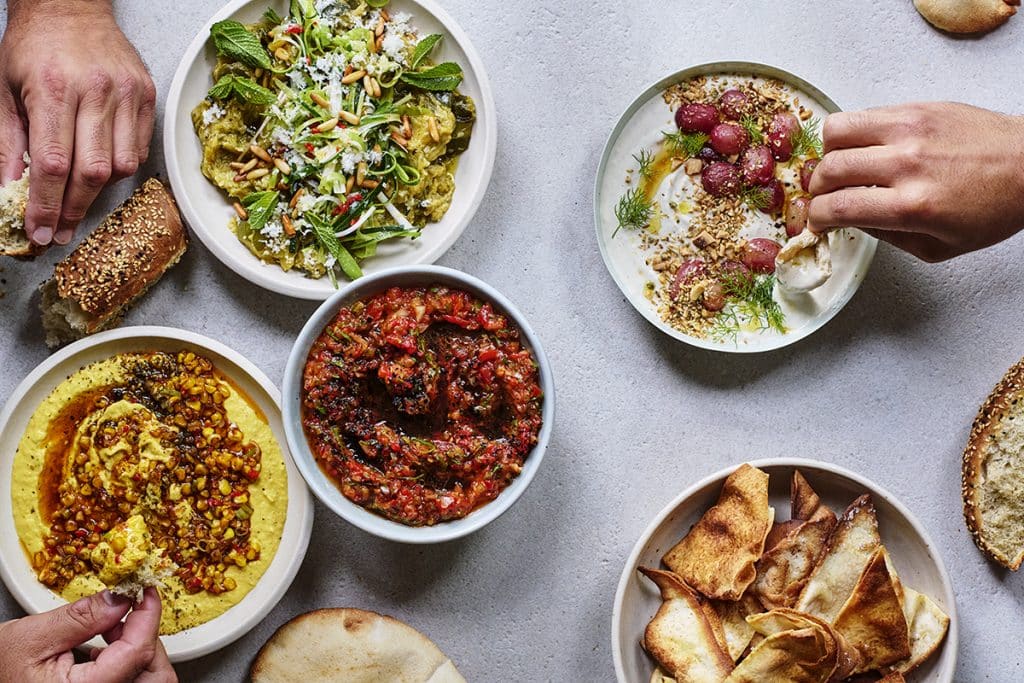
Has food always been important to you?
Yes, since I was a kid. My first memory of cooking is when I was seven or eight and made my parents an anniversary meal: steak with tinned petit pois. My grandfather had Wimpy bars in the late 60s and early 70s and my grandparents on my mother’s side both loved to cook. I cooked with them as a child – lots of fingers in bowls. Later, in my teens, I remember asking my mum what was for dinner, and then asking if I could have all the ingredients so I could cook my own version. I used every pot and pan in the process – really enthusiastic about the cooking, not so much the washing up. She tolerated me tearing the kitchen to pieces every night though, because she knew I loved it.
So, how did you come to be involved with a Levantine food business in Borough Market?
It started in Borneo, of all places, halfway up Mount Kinabalu. The night before scaling the summit, I met an English couple in the refuge, both teachers from Brockley. I was travelling alone, and it was the first proper conversation I’d had for a few days. We got talking about food. They said: “Have you heard about this food market that’s started in Borough? It’s amazing.” We agreed that we’d meet at the market when we got back to London. I remember it was a spring morning, and I got there early and sat on the pavement with a coffee, just watching everything. I watched the banter, watched the stalls unpack, watched the traders getting set up. There’s something beautiful about that.

Beautiful in what way?
Every new city I go to, I get up early in the morning and go to the food market. I’ve done it all over the world. You breathe it all in, the noise and the smells. You get a sense of where you are, what people are eating, how they’re behaving. You just suck it all up and it’s a magical thing. That morning at Borough, I was like: “This place is amazing.” Quality food, provenance led, shoppers who wanted something more than a supermarket. I’d found my place. One of the stalls we stopped at was Jad’s. He was there behind a little fold-up table, with three or four meze, bread, olive oil and some za’atar. I tasted it: I dipped the bread into the oil, then into the za’atar, and it was like “bang”. Explosion. Then we started talking. Jad was such a good conversationalist, and I had so many questions. I was kind of mesmerised by him – big aura, lots of love, a real giver, very generous with his time and ideas. Anyway, we took each other’s numbers.
What were you doing at the time?
I was working as a chef, but with no formal training. As a kid, I was expelled from school. Looking back, it was likely a mix of old-school teaching methods and undiagnosed ADHD tendencies, but at the time, I was simply labelled the ‘naughty kid’ – always in trouble, always restless. I dropped out and got a job at Bluebird Café, but that only lasted six months. I didn’t like the hierarchy, hated the way the sous-chefs talked to me. After a couple other short-lived roles, I was working in a pub in Camberwell. I was having this real struggle, because I was so passionate about cooking, but knew that if I stayed working in these environments it was going to end up killing that love. I found myself going to the Market every Saturday. One day I got the courage up to call Jad and say: “What time do you finish up? Could I come and help you pack down?” We went to the pub that evening with all the other traders, had a beautiful time, met all these characters. I knew I’d found my tribe. The next week asked Jad if I could come down every Saturday and help out for free.
How did you go from unpaid helper to a partner in the business?
Not long after I got here, Borough started allowing hot food one day a week. At first, Jad started selling tagines, but after a few months he pulled me aside and said: “Listen, I’ve got an idea. I’ll teach you how to make falafel. Keep whatever you make, and when the falafel makes as much money as the meze, we’re partners.” That was the deal. I bought a hand mincer with a tiny little hopper, frustratingly tiny. I had a small saucepan, a slotted spoon and a kilo of chickpeas. At the end of the first day I had £100. Week two I bought three kilos of chickpeas and a bigger fryer and still sold out in an hour. After a couple of months I was able to buy a mincer. Every week we sold more and more. It was on the Queen’s Jubilee that I absolutely smashed it out the park. There was a celebration weekend at Smithfield and a selection of traders were invited from Borough Market. We made so much money, Jad was like: “Well, I guess we’re partners!”

When did you first visit the eastern Mediterranean?
It was the summer of 2005. Until that point, everything I knew had been passed down to me by Jad. After Café Arabica closed, the two of us took a trip to Jordan for a few weeks of repairing and healing. We went out to the desert. We collected milk to make labneh. We picked beautiful Persian cucumbers off the tree to be eaten 10 minutes later. We picked vine leaves off the vines. We cooked these amazing meals with Jad’s sister – experiencing that food culture first-hand in someone’s home is such a privilege. We played backgammon and drank mint tea. One day we took day trip to Syria, to Damascus, a city bursting with history. I’ll never forget wandering through its breathtaking souks – a sensory overload of colours, spices and energy.
What is it that appeals to you so much about the region’s food?
I’ve always had a natural appreciation of Mediterranean food. I love simplicity on a plate. In that part of the world, there can be a lot of ingredients in some recipes, but there aren’t these complex cooking techniques. It’s much more about quality: take a really good tomato, put some good olive oil on it and some nice salt and let that tomato shout. The Mediterranean is so interesting because they share a lot of the same approaches. Depending on where you are – village to village, family to family and across the region – there are all these huge connections but also these incredible local nuances. At Arabica, we call what we do ‘eastern Mediterranean’ because it doesn’t confine us in the same way that homing in on a particular country would. It allows you to be creative and blur boundaries.
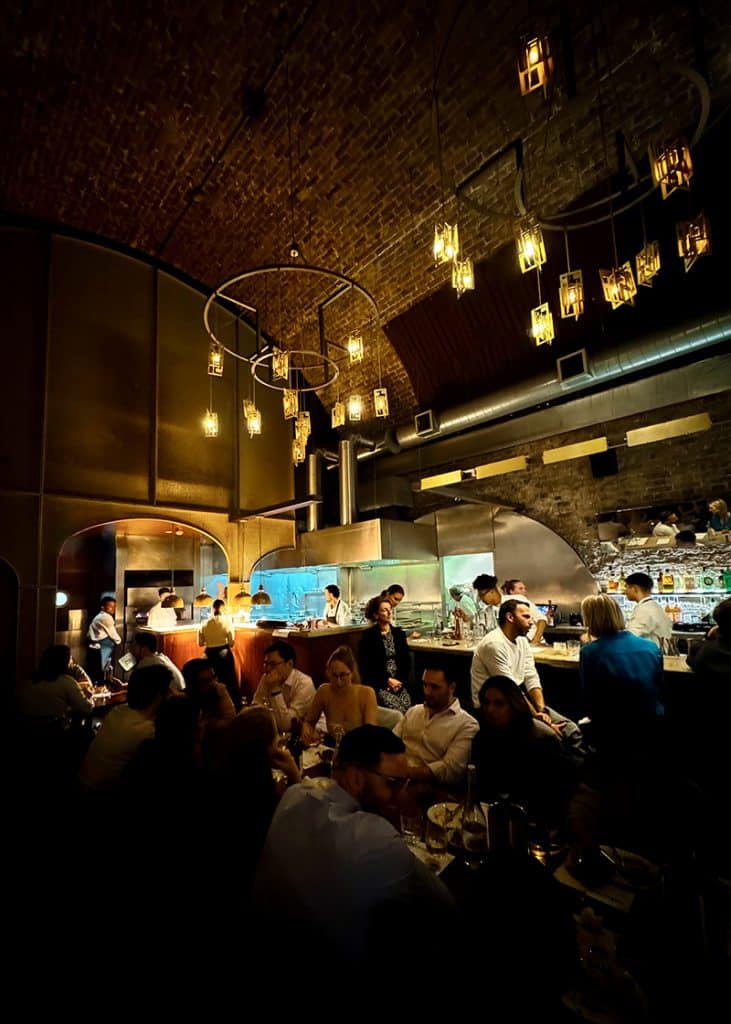
Does that stop people arguing with you about authenticity?
No. We do this chicken and pistachio shish, one of the most popular dishes on our menu. We’ll get people who come in and go: “This isn’t shish.” What does ‘shish’ mean? It means skewer. Does it have a skewer in it? Yes. Could you get all the ingredients at a local market in Jordan, Lebanon or Turkey? Yes. So, it’s a shish. But it’s not the way their grandmother did it, so it’s not right. Everyone’s so passionate: “My mum’s kleftiko is better than yours” or “Uncle so-and-so is the best on the barbecue”. I love that passion, though. You have to agree to disagree and be open to exchanging ideas. That’s what makes food so exciting.
One thing that every part of the region shares is an emphasis on hospitality. That must make your travels all the more enjoyable.
I’ll tell you the funniest thing about one of my first meals in Jordan. We’re all sitting on the floor together, with a bowl of fresh labneh, homemade pickles, a fattoush salad and this massive plate of beautiful stuffed vine leaves. When I finish my first plate, they top me up with a second. Then a third. I don’t want to be rude, so even though I’m full, I’m slowly getting through it. It gets to the point where I’m rolling onto the floor, moaning, about to explode, and they’re all laughing their heads off. Jad’s sister Rada, with this little glint in her eye, leans over and pops one last stuffed vine leaf into my mouth. Finally, Jad says: “By the way James, you have to leave a little bit of food on your plate to symbolise that you’ve been well looked after. If you finish it, they think they haven’t done a good job.” I had no idea!
Arabica: Small Plates, Big Connections by James Walters (Carnival) is available now at The Borough Market Store
Read James’s recipes
Q&A: Otto Boyer
The co-founder of JENKI on finding the perfect matcha, whisking it the traditional way, and persuading coffee drinkers to give it a try
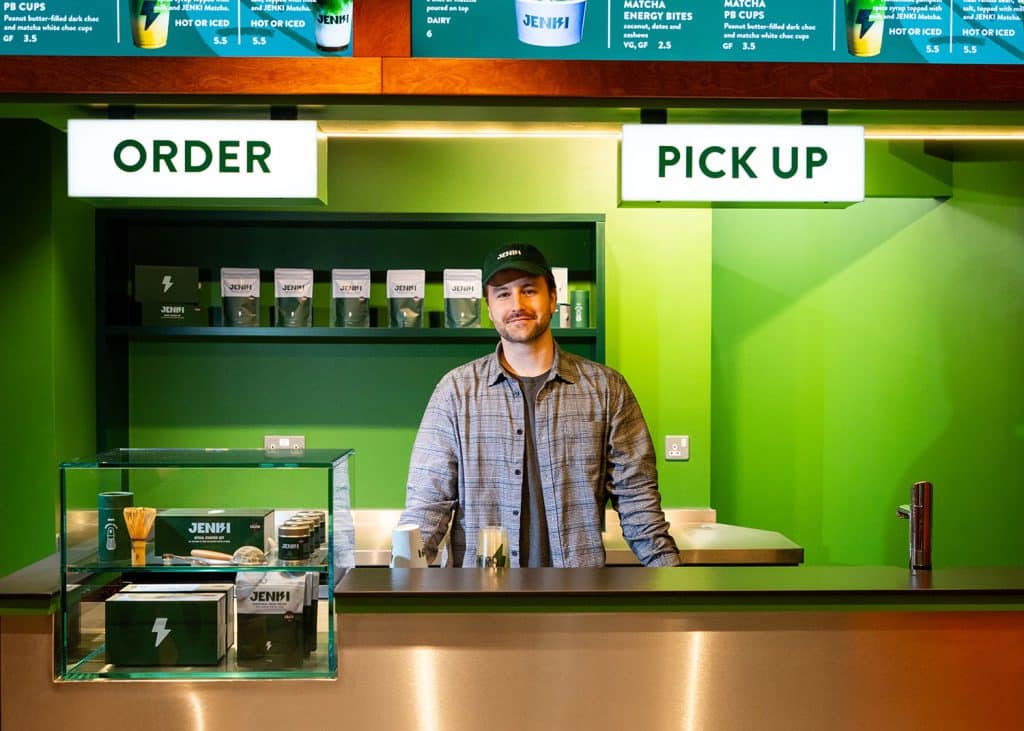

“WHISKING THE MATCHA IS ALMOST LIKE A MOMENT OF BLOOMING, WHEN THE FLAVOUR COMES OUT IN ITS TRUEST FORM”
Interview: Mark Riddaway
It was while growing up in Hong Kong that Otto Boyer first discovered matcha. “We spent a lot of time visiting Japan,” he explains. “My parents had lived out there and my dad speaks Japanese.” Matcha – an energising beverage with a vivid pea-green colour – has for hundreds of years been deeply embedded in Japanese culture. Having fallen in love with the drink, Otto struggled with its relative scarcity in London. “Over here, I wanted to have matcha as an option in my day-to-day routine, but it was so hard to find.”
His solution to this problem was certainly a robust one: co-founding a business that imports single origin matcha from Uji, close to the historic Japanese city of Kyoto, and sells it through four London-based matcha bars, the newest of which, Whisk by JENKI, opened in Borough Market in 2024. “My wife Claudia and I set up JENKI about five years ago,” says Otto. “We weren’t married at the time, and it felt like a big gamble. We knew that either our relationship wouldn’t survive, or the business wouldn’t survive, or that both would be great.” Thankfully for them – and for the London’s growing ranks of matcha afficionados – it’s very much the latter.
Let’s start with the basics. What is matcha?
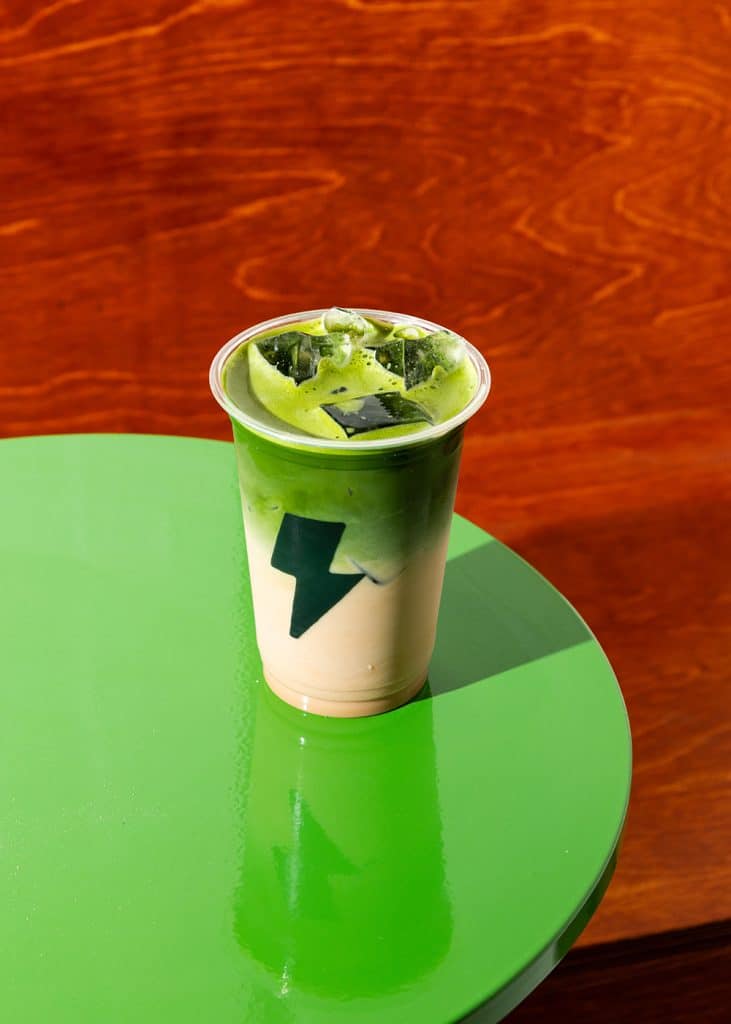
In simple terms, matcha is very finely ground green tea leaves. With other types of tea, you’re typically steeping the leaves before discarding them completely and drinking what’s left behind. With matcha, you’re ingesting the whole of the tea leaf. Matcha can be made elsewhere around the world but the best matcha is made in Japan, using a method developed over hundreds of years. It’s the same plant used for other teas – the Camellia sinensis plant – but you’re only picking the smallest, sweetest, most succulent leaves at the top. You’re steaming, drying, deveining and de-stemming the tea leaf itself, then grinding it into an ultra-fine powder using traditional stone mills. It takes an hour to manufacture 30 grams of matcha, so it’s a time-intensive process.
Is all matcha made that way?
No, there’s a huge range of quality. A lot of what is sold as matcha on the high street is made in China using methods that aren’t even close to the traditional Japanese production process – it’s really just ground-up green tea. It ends up being this muddy brown product, with quite an earthy, bitter taste. What we’re trying to do is educate the London consumer as to what quality matcha can taste like. We sell what is commonly referred to as ceremonial-grade matcha – the highest grade – but even within that bracket there’s a lot of variation. A matcha sourced from Uji will taste quite different to a matcha sourced down in Kagoshima, which has a more tropical climate and different soils. Every producer has their own tea master, whose job it is to blend the tea to create the flavour profile they’re looking for. It’s a true artform.
How would you characterise the profile of the matcha you sell?
It’s very approachable – mellow and smooth with sweet, nutty and slightly umami notes. We’ve purposefully chosen one that isn’t too bitter and punchy so that it’s accessible to a matcha newbie. When we first started JENKI, we toured around a lot of different farms trying to find the ideal supplier. We wanted a family-run farm that was still using very traditional methods, milling the matcha using stone mills. We love that we’re championing that sense of heritage, but mostly it’s about the quality – modern machines simply can’t create the same texture. We’ve never found a matcha that can compare to how smooth and mellow ours is.
As an energising drink, how does matcha compare with coffee?
I’ve been an avid coffee drinker in the past, but I can’t drink coffee after lunchtime. Matcha has a different concentration of caffeine and contains a compound called L-theanine which acts as a caffeine uptake regulator. So, instead of a sharp jittery spike followed by a crash that makes you think you need another coffee, matcha offers five or six hours of caffeinated energy with a very gradual uplift and a very slow tapering off. It’s longer lasting, but that gradual uplift will give you a calmer, more focused energy. When we started in 2021 with our first bar in Spitalfields, we also served coffee as a way of pulling people in. We’d then ambush them with a crash course in what matcha was and why they should try it. Pretty soon, we were able to ditch the coffee and people kept coming back for the matcha.
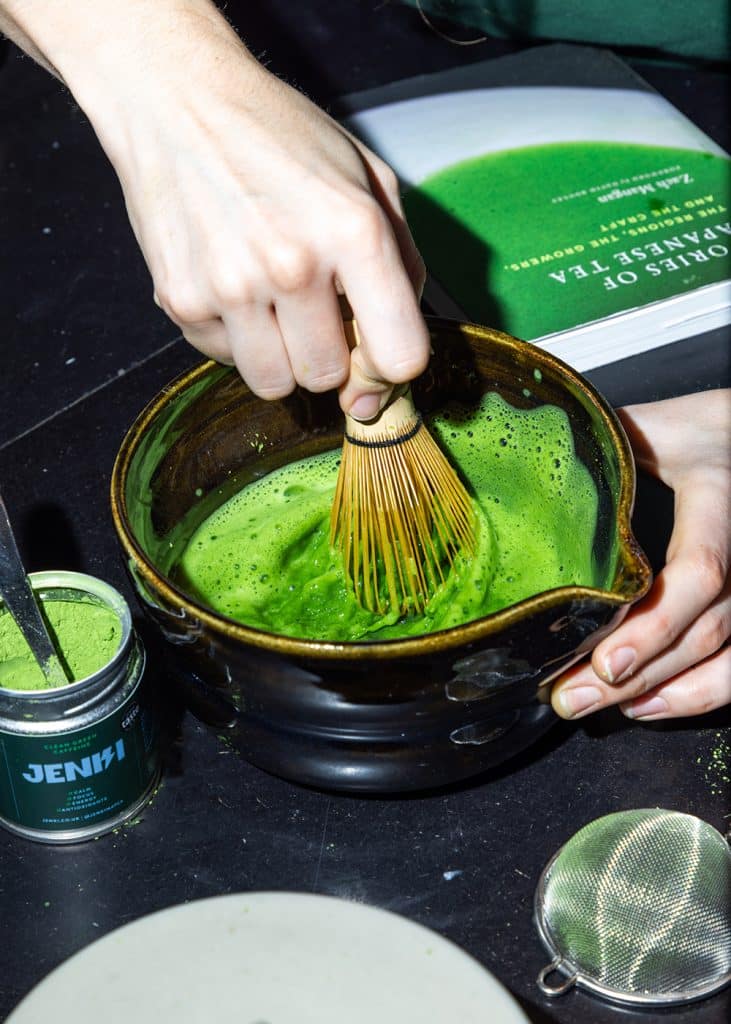
While the matcha you use is produced in an age-old way, your menu is far broader and more creative than you’d find in a traditional Japanese tea house. What’s your thinking?
Part of what we’re trying to do is make matcha a little more accessible to people who are used to drinking coffee. The traditional Japanese style, just matcha with water, we call a ‘matchacano’. We have matcha lattes and a ‘flat green’, which is basically a flat white with matcha. Most of the products we sell are straight-up matchas, but we’re also trying to appeal to a younger generation who want sweetness, colour and creativity and are interested in health benefits, hence our shakes, syrups and boosts.
You hand whisk every single order. What does that involve?
The traditional way to prepare matcha is with a bamboo whisk in a bowl with warm water – not boiling water, as that will burn it. Whisking releases the full flavour within – it’s almost like a moment of blooming, when the flavour comes out in its truest form. You’ve got to work it quite vigorously, resulting in a foamy solution full of bubbles, with no lumps anywhere. Some bars will prepare their matcha in batches in a blender, but it’s just not the same. We insist on doing it to order.
How did you go about establishing your business?
Claudia and I started by doing some small pop-ups in markets. We did our first one in Brick Lane, which was a disaster – we were there on a Saturday morning with a health product, and everybody else was there looking for greasy hangover cures. That was an eye-opener. We then did a pop-up in Old Street station the week before Covid arrived. Covid was a time where we could really focus on what our offering should be. We opened our first bar in July 2021. We didn’t have any employees apart from me, Claudia and my younger brother. I think we did four and a half months behind the bar, seven days a week straight. We’re in a very different place now. We’ve got nearly 80 people in the team, working across four bars. We’ve now got two identical twins as well, so there’s a lot going on!
As you grow, what kind of employer do you want to be?
Actually, the process of onboarding with Borough Market was really interesting, as the questions they asked made us really think about the standards we want to uphold as employers. Paying the London Living Wage, as an example, is really important to us. Building a work culture we can be proud of is also really important. We want people to enjoy coming to work. Ensuring we find ways of continuing to make that happen is probably one of the most satisfying parts of growing a business.
Q&A: Chloe Stygall
For International Women’s Day, one of Ginger Pig’s butchers discusses gender stereotypes, learning a new skill, and why understand cookery is a vital part of the job
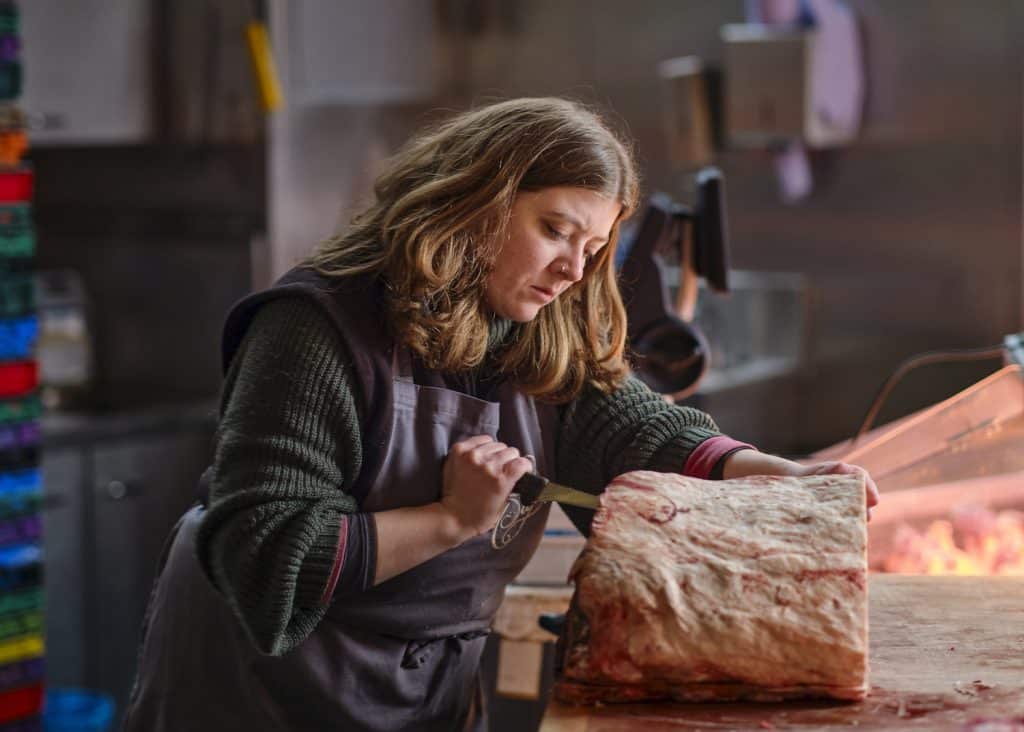

“I HAD LITERALLY NO EXPERIENCE OF BUTCHERY. BUT NOW THAT I’M DOING IT, I REALLY LOVE IT”
Interview: Mark Riddaway / Portrait: Orlando Gili
Of all the food-related professions, butchery is among the most conspicuously male. With its knives and saws, blood and viscera, it has for hundreds of years been deemed the domain of men, and it mostly remains that way. There is, of course, no logical reason why a woman can’t become as accomplished a butcher as any burly bloke, but not many consider this ancient craft as a potential career. Chloe Stygall, assistant manager of Borough Market’s Ginger Pig butcher’s shop, certainly didn’t. “This wasn’t necessarily something I ever thought I’d be doing!” she says with a laugh.
For several years, Chloe had been working as a server for one of the Market’s continental food importers. In that time, she’d become friendly with Isaac, the manager of the Ginger Pig stand, and it was he who suggested she make a new start. “I’d reached a point where I wasn’t really sure what I wanted to do with my life,” she recalls. “He said: ‘Well, why don’t you come here and try this for a little while, just to see if you like it?’” And like it she most certainly did. “Obviously, I really love and care about food – that’s one of the reasons I wanted to work in the market in the first place – but it was still a bit of a swerve! I had literally no experience of butchery. But now that I’m doing it, I really love it.”
What is it about the work that appeals to you so much?
I hope this doesn’t sound too weird, but I love how tactile it is. I love how much you rely on touch and feel. I really enjoy working with my hands and doing something physical and skilled. I also love the sense of achievement you get at doing it well. When you’re breaking down a carcass and getting the different joints out, then tying it all up for the window, making it look good and seeing the end product of your work, it’s such a satisfying feeling. Also, I love the amount I’ve learnt about cooking. I didn’t really eat much meat before I started working here, but that’s completely changed now!
So, have you learnt your craft on the job rather than through formal training?
Yes – and I’m still learning, every single day. I started by just trimming out the offcuts for mince and then worked my way up to the bigger cuts, eventually all the way up to the whole carcass stuff. I’m not doing a qualification or anything like that, I’m just meeting the demands of the job and learning from the experienced people around me. We sell quite specific things in the shop, because of its location and clientele, so while I’m now good with those cuts, there’s an awful lot I still have to learn. It never ends, but that’s one of the great things about it.
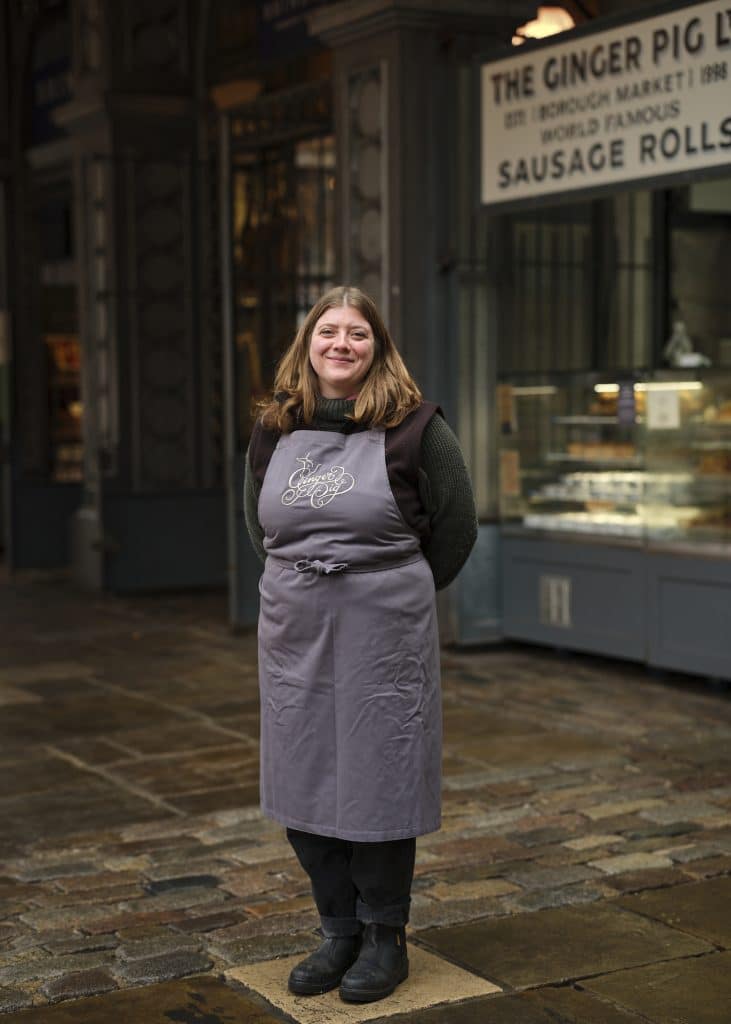
To be the best possible butcher, do you need to have people skills as well as knife skills?
I think you do. A big part of working in a butcher’s shop is that people are always asking you how to prepare and cook things. They want recipes, timings, temperatures and lots of other advice, so being able to figure it all out for so many different cuts of meat and then relay that knowledge in a way that’s easy to understand is really important. I enjoy that aspect a lot, and it’s made me a much better cook along the way.
What do you do if people come in asking for unusual cuts that you don’t have out on the counter?
We’ll always endeavour to get stuff in for people if they’re looking for something specific, although there will be times where we’re not able to do that. A lot of international customers will come in asking for a specific cut that I’ve got no idea about. That’s when you do a bit of googling to see if it translates into something more familiar. That does happen quite often. Again, I’m always learning!
Even in this day and age, it’s unusual to see a female butcher. Do you ever feel judged on the basis of your sex?
Yes, absolutely, 100 percent. Quite often I’ll start serving someone, and they’ll ignore me and begin talking to one of the men, because it’s the men who fit their image of a what a proper butcher should be. There are two female butchers in our shop, and I’m actually the assistant manager, but some customers will always gravitate to one of the guys.
There is a flip side, though. Isaac, the manager here, has tried really hard to change the dynamics of the shop by taking chances on people who you wouldn’t traditionally find in a butcher’s shop. I know for a fact that certain customers are more comfortable coming here as a result. Personally, before working here, I would have felt a bit intimidated by the thought of going into a butcher’s shop and not really knowing what to ask for, and a lot of people are the same. I’ve had quite a lot of female customers tell me how refreshing it is to see a woman behind the block and how much more relaxed they feel about coming in and asking questions. I think that’s great.
At Ginger Pig, you spend your days working with high-quality meat from animals that have been raised with care. Has that changed your own shopping and eating habits?
Totally. Working here has given me much more of an understanding of how animals are raised and what impact that has, on them and on the meat. Here, you can see and feel the quality. We know where everything has come from, who’s produced it and the conditions it was produced in. I just wouldn’t buy meat from a supermarket now. To be honest, it’s just a completely different thing.
What are some of the more unusual meats you enjoy that you would encourage other people to seek out?
The pigeons – we get these really nice farmed pigeons. I don’t think enough people realise quite how delicious pigeon can be. The other thing I’ve discovered is onglet, which is a cut of beef. It’s a skirt steak, but it hangs internally, so it’s got a richer, more iron-y flavour to it. Kind of offal-y. That’s really good. You have to sear it very quickly on a very high heat. It can be slightly unforgiving if you get it wrong, but if you cook it quickly and then cut it against the grain it’s so tender and so delicious.
You’ve been working at the market for many years now. What is it about the environment that keeps you coming back?
It’s just a really lovely community, a really lovely vibe. Everyone looks after each other. I’ve met lots of friends working here. I wouldn’t want to be anywhere else.
IWD

